Shrubs decorative for hedges. Hedge - what is better to make
If you are thinking about how to enclose your site, allocate a flower bed or divide the territory into several zones and do it effectively, arranging a hedge can be an excellent solution to this problem. First you need to decide for what purpose you will do this, how high the green fence should be, and which plants in your area take root most easily and feel comfortable.
Consider the main types of hedges and try to figure out which plants are suitable for them. Green fences can be:
- deciduous
- coniferous
- shorn
- free growing
- low
- average
- high
- decorative
- single row
- multi-row
Experienced gardeners can certainly identify several more types of hedges from living plants. And in order to start somewhere, let's try to pick up greenery for the above types of fences.
Deciduous hedges
Such green fences are distinguished by their unpretentiousness, and also make it possible for diffused light to penetrate all parts of the garden. In addition, deciduous plants take root perfectly in all regions of our country. You should only select trees and shrubs that are accustomed to the climatic conditions of your region.
The main difference between such fences is that they are decorative only in the warm season, when they are covered with greenery. In winter, they can perform the function of zoning and dividing plots. Most often, plants such as viburnum, spirea, willow, euonymus, jasmine, honeysuckle, acacia and others are used to equip deciduous hedges.
In order not to suffer while waiting for the fence to become lush and beautiful, you can pick up fast-growing hedge plants. Let's consider some of them.
A beautiful deciduous shrub with purple-red or yellow leaves. This is one of the most favorite plants for gardeners to grow in suburban areas.

Leaves of different shades give decorativeness to the shrub: from white to purple. Even when all the leaves fly around, the bush remains beautiful, decorated with many berries.

Privet. Gardeners are very fond of privet for the ability to create the most bizarre shapes and figures from it, because it lends itself perfectly to a haircut.

Shiny dark leaves are a real decoration of this shrub. In autumn, they become bright crimson in color, and many red berries will please the eye even before the frost.
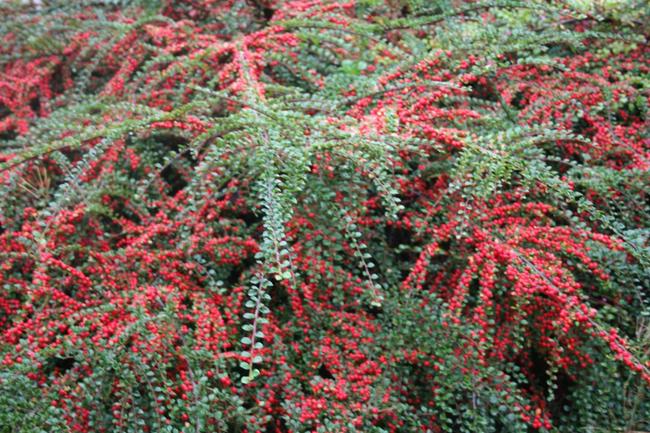
Forsythia. Dense succulent foliage remains decorative until the onset of the cold season.
 Forsythia yellow
Forsythia yellow Most deciduous plants bloom profusely in spring or summer, giving the hedge a special glamor. Some of them give a lot of bright-colored berries, increasing the period of decorativeness until the very cold.
Coniferous hedges
36N2T9sKUUc
To make an evergreen fence in your area, you should use only those types of conifers that are suitable for your climate. Then they will delight with their splendor and exquisite appearance. As a green fence you can plant:
Spruce. Spruce species such as Serbian, gray-gray or dwarf Canadian are excellent for arranging hedges.
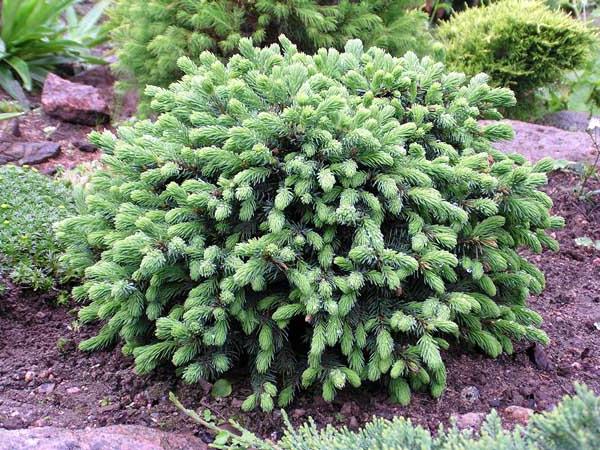
Juniper is very popular with gardeners. The following types are distinguished by their unpretentiousness: ordinary, horizontal, virgin, Cossack, Chinese.
 Hedge juniper
Hedge juniper Fir. It can be used for arranging a living fence only outside the city, as it does not tolerate smog.
 The appearance of a fir fence
The appearance of a fir fence Pine. Mountain, Weymouth and ordinary pine are distinguished by decorativeness.
 An example of a pine hedge
An example of a pine hedge Of all evergreens, it is not only highly decorative, but also frost-resistant.
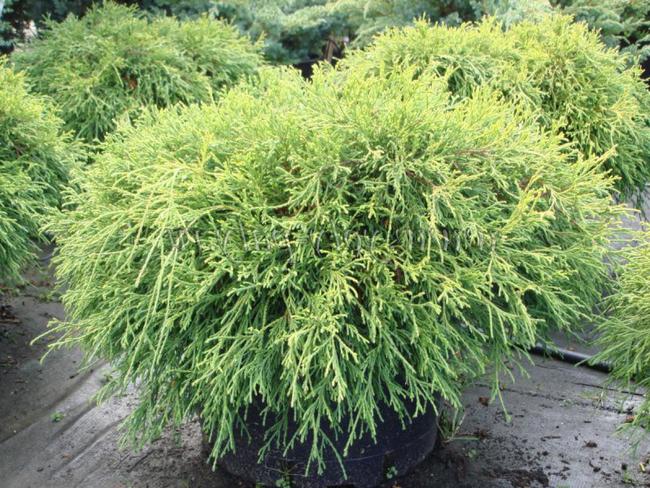
Thuya. Novice gardeners should pay attention to the western one, which comes in different shapes and varieties, starting with plants 60 cm high, ending with 15-meter specimens.
 Thuja western
Thuja western Coniferous hedge- this is not just a storehouse of oxygen in your area, it is also an excellent protection against climatic disasters, prying eyes, as well as bright greenery all year round.
sheared fence
As a basis for arranging a sheared hedge, you can take only those plants that lend themselves well to shearing. Such a fence or border always has a well-groomed appearance, but requires a lot of attention.
For arranging hedges that you plan to give certain shapes, you can use different types plants. It can be both coniferous and deciduous trees and shrubs.
Green fences from thuja, juniper need to be cut regularly, giving them the appearance of a trapezoid or rectangle. Spruce also requires regular shearing. Barberry differs in that it retains its shape after pruning for a long time. Privet lends itself well to shearing, so hedges can easily be given any shape. If you cut the hawthorn bushes in a timely manner, then you can make a thick impenetrable fence.
Free growing fences
If the territory allows, then on the site you can make a hedge of freely growing plants. It will take up a lot of space, but it will not require any maintenance.
Various types of juniper are excellent for this purpose. . This plant is highly decorative, showy forms. In addition, the greenery on your site will be provided year-round.
low hedges
Low curb hedges are most often used to accentuate flower beds or divide the territory into separate sections. The height of such miniature fences can be from 20 to 70 cm.
The following plants are suitable as the main plant for arranging a low curb:
Chubushnik "Gnome". This undersized mock orange variety does not bloom and has a dense green crown. The density of the branches allows pruning, giving the hedge the desired shape.
 Chubushnik "Gnome"
Chubushnik "Gnome" Japonica. Decorativeness of this plant is given not only by dense foliage, but also by flowering in spring, and ripened fruits in autumn. The undersized plant has a dense crown, thinning of which should be done once every two years.
 Japonica
Japonica branchy, evergreen shrub common heather can also be used for low hedges. It lends itself well to pruning, and its decorative properties increase during flowering.
willow alpine unpretentious, grows on any soil. And although it is a short plant with straight shoots, it needs regular trimming to keep it compact.
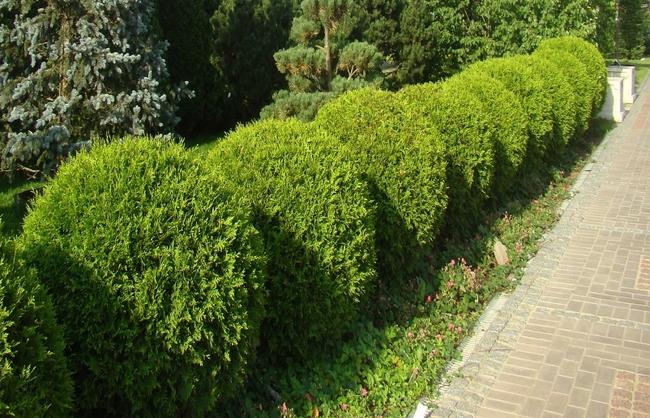
Loves shade. exquisite evergreen unpretentious to the composition of the soil. And although in our country this plant is considered exclusively decorative, the dark blue mahonia berries are quite edible.

Hedges of medium height
With the help of plants up to 2 meters high, you can make a living fence, which will also be an excellent protection for fruit trees from strong winds, and will be able to hide your site from prying eyes, and cover an unsightly outbuilding. A medium height hedge can be planted from the following plants:
Elderberry grows quickly, so it requires frequent pruning. Beautiful inflorescences and berries during the fruiting period give it special beauty.

Hydrangea arborescens blooms profusely and for a long time. Hemispherical shrubs reach a height of 1.5 meters. It is better to buy it from manufacturers who have grown hydrangeas in the same climatic zone where you are going to plant them.

Kalina. This plant can be trimmed to any shape. The bright green viburnum, its lush flowering and bright red berries will delight the eye from early spring to late autumn.

Spirea. This variety of deciduous shrubs has many varieties. The plant grows quickly, so after 3 years you will get a durable decorative hedge.

Lilac. With the help of this ornamental shrub you can create an impenetrable fence, since the lower part of the plant is heavily overgrown with shoots. Lilac is especially good during the flowering period.
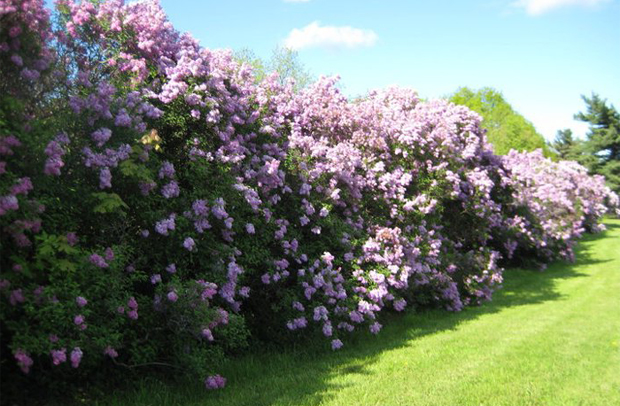 Lilac hedge
Lilac hedge tall plant hedges
The task of high living fences, which can reach a height of 2 to 6 meters, is to hide the site from prying eyes, protect it from wind and dust, and shade the desired area. For this purpose, different trees and shrubs are used.
Bird cherry. Numerous varieties of this tree allow you to choose the right option for planting a live fence.
Honeysuckle. This plant is ornamental with beautiful leaves and berries of bright color. Honeysuckle is drought- and frost-resistant, loves shady places.
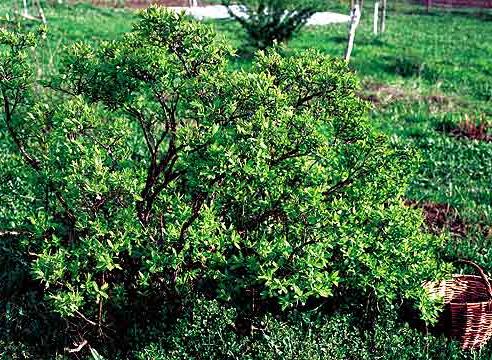
Hydrangea paniculata. Bushes and trees can reach a height of 7-8 meters. Especially decorative during the flowering period - from mid-June to late October.
 Hydrangea paniculata
Hydrangea paniculata This slow growing redwood is renowned for its bactericidal properties. The decorative qualities of yew are widely used to create labyrinths in gardens and park areas.
 Yew berry
Yew berry Decorative green fences
Perennial climbing plants and tree vines are widely used for ornamental hedges. With their help, you can hide certain parts of the garden and just make a luxurious hedge. It should be borne in mind that for the arrangement of such a fence you need a strong frame, preferably a metal one. The most popular climbing plants:
The woody deciduous liana kampsis is a giant of wondrous beauty, the decorative effect of which is created by sprawling branches and abundant bright flowering. The plant tolerates drought well, but in order for the vine to bloom as long as possible, it needs to be watered more often.
 Liana kampsis
Liana kampsis Prefers a warm and humid climate. Liana covers the entire frame with dense greenery, and ripe cones, which are medicinal, give special sophistication to the plant.

Often used for vertical gardening climbing rose. These shrubs love warm, mild climates, but you can find varieties suitable for northern areas.

Clematis is a rather finicky climbing liana, but after working hard, you can get an unusually beautiful hedge to the envy of all neighbors.
 Clematis - appearance
Clematis - appearance Single and multi-row hedges
If there is no need to close the entire area from dust, wind, then single-row hedges can be planted. For this purpose, one type of plant of the same height is usually taken.
For greater protection, plants are planted in several rows. Choose instances of different heights to create a dense impenetrable wall.
Properly selected plants for hedges will delight you for many years. And for fans of design delights in the issue of arranging green fences, there is a wide field of activity.
In our area it is not so often possible to meet a hedge, but in last years this method of landscaping is beginning to be actively used by our summer residents. And there is absolutely nothing surprising in this. Hedges not only play the role of a traditional fence, but are also extremely beautiful. Using thickets of shrubs, you can create a great place to relax. But what is the best thing to make a hedge?
Kinds
First you need to figure out what they generally are. Only then can you think about which shrubs are best used in your specific case. First, they are divided into formed and freely growing (only occasionally trimmed). Of course, the first category is most often found on personal plots. An exception can be made if you need the original fencing of a pasture or vegetable garden.
By height, all hedges can be divided into the following varieties:
- Tall, more than two meters.
- Medium height, from 50 cm to a couple of meters.
- Low, whose height does not exceed half a meter.
Other characteristics are closely related to the biological characteristics of the species that were used to create them:
- Evergreen and deciduous.
- With and without spines.
Main range
So what is the best way to make a hedge? Given that in the same England, such plantings are already one of the sides of the national culture, for many centuries basic recommendations have been developed that all gardeners should be aware of.
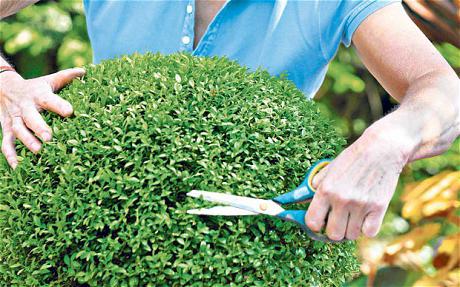 We will list the main types that can be used without any special restrictions in the climatic conditions of our country. We will not give a detailed biological characteristic, since data of this kind do not play a special role for these purposes. In general, based on the classification that we have given above, we can recommend a huge number of trees and shrubs. Consider what is better to make a tall category hedge.
We will list the main types that can be used without any special restrictions in the climatic conditions of our country. We will not give a detailed biological characteristic, since data of this kind do not play a special role for these purposes. In general, based on the classification that we have given above, we can recommend a huge number of trees and shrubs. Consider what is better to make a tall category hedge.
Tall deciduous trees
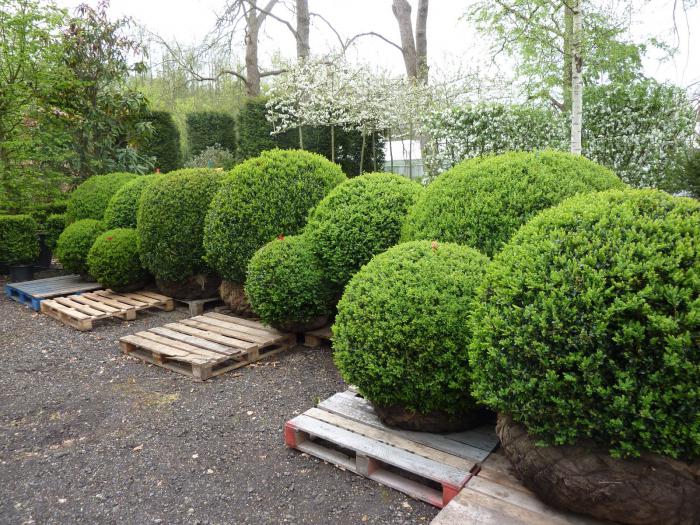
And what is the best way to make a hedge if these trees are not at hand? Mulberry is perfect, as well as common maple. We strongly do not recommend confusing the latter species with American maple, which, with its “impellers”, is able to turn hectares of land into thickets of its seedlings. If you need a barbed fence, you'll have to find
For aesthetic hedges, you can plant lilacs, honeysuckle (delicious fruits), currants and meadowsweet, as well as acacia, shadberry and mountain ash. As for the irgi (a beautiful fast-growing hedge), it will have to be constantly thinned out, getting rid of young shoots growing in all directions. In addition, during the fruiting season, a huge number of sparrows will gather on these trees, which is far from desirable in all cases.
thorny hedges
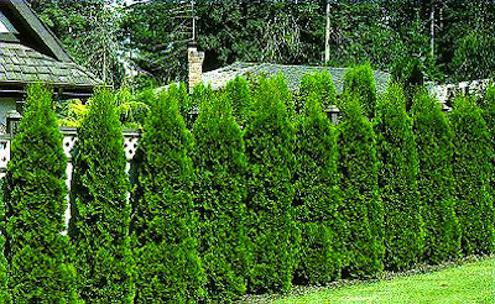 For these purposes, scarlet pyracantha is widely used. It is not very common, as it is suitable only for the southern regions. Forms very dense hedges, decorated with orange-yellow berries, which remain on the bush for a very long time. A plant with a curious name has proven itself in arid conditions, as it is practically not picky about soil quality and irrigation.
For these purposes, scarlet pyracantha is widely used. It is not very common, as it is suitable only for the southern regions. Forms very dense hedges, decorated with orange-yellow berries, which remain on the bush for a very long time. A plant with a curious name has proven itself in arid conditions, as it is practically not picky about soil quality and irrigation.
This also includes the same juniper and thuja, hawthorn and even the hornbeam we mentioned. Of course, in this case, you will have to put more effort into its constant shaping and cutting.
We make low-growing hedges
In another way, they are also called curbs. The range of species in this case is not so wide, so there is not much to choose from.
Firstly, evergreen boxwood may come up. Very shade tolerant, extremely slow growing. In addition, in most of our regions, in cold winters, it has a tendency to freeze. The hedge also proved to be quite “loose”, but it blooms very beautifully, and its berries are very decorative. In addition, this shrub belongs to the category of shade-tolerant.
It is extremely important to adhere to the timing of planting in open ground, as well as to correctly select the right soil and the types of fertilizers used. The earlier you plant a tree, the easier it will be in the future. Deciduous cultures best tolerate transplantation at 2-3 years, and conifers at a maximum of five years. The fact is that it is from this age that it is best to start molding plants.
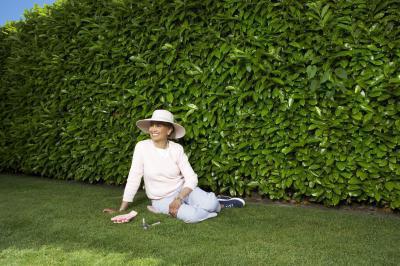 Secondly, be sure to mark the landing site by pulling a twine for this purpose. Don't try landing "by eye" as you are unlikely to be able to achieve a truly direct landing based solely on your eye gauge. A beautiful hedge, the photo of which is in the article, always has regular geometric shapes.
Secondly, be sure to mark the landing site by pulling a twine for this purpose. Don't try landing "by eye" as you are unlikely to be able to achieve a truly direct landing based solely on your eye gauge. A beautiful hedge, the photo of which is in the article, always has regular geometric shapes.
How to plant?
Depending on the number of rows, we dig a trench of the required width. Please note that gaps of at least 60 centimeters should be left between plants (if the fence is free, then from 1.5 meters), and gaps of 25-50 cm should be made between rows. If planting in two or more rows, use a checkerboard pattern.
Be sure to take care of the fertility and moisture of the soil. If there is such a need, it is advisable to apply the necessary types of mineral and / or organic fertilizers, after which the planting holes should be properly watered. If we are talking about hardwoods, then the root system of trees should be kept in water for a couple of hours before planting, and then dipped in liquid clay (creamy consistency) mixed with humus.
The landing itself is also highly desirable to do according to the level. Near each planted plant, it is necessary to carefully compact the soil. It is necessary to water each bush in two or three passes, so that the water has time to be absorbed and reach the roots of the plants. As for conifers, they should generally be planted along with the clod of earth with which they were acquired. In this case, the hedge, for which plants sometimes have to be bought, has a better chance of surviving.
Trimming and shaping
After planting, plants should never be pruned. This event has been postponed for at least one year. An exception may be some species of coniferous trees. Subsequently, the plants are pruned at the moment when their young shoots begin to slightly lignify. At least two live buds should be left on each branch.
 As for the annual growth, in the first two or three seasons, a minimum of 15-20 cm should be left, subsequently reducing this value to a couple of centimeters. It is best to shorten the plants in early spring, as well as three times throughout the summer. Attention! The last pruning should be done at least one month before the onset of stable cold weather.
As for the annual growth, in the first two or three seasons, a minimum of 15-20 cm should be left, subsequently reducing this value to a couple of centimeters. It is best to shorten the plants in early spring, as well as three times throughout the summer. Attention! The last pruning should be done at least one month before the onset of stable cold weather.
Care
It should not be forgotten that the hedge, the bushes of which adorn your site, is not maintained by a single pruning. She needs watering, weeding from weeds and top dressing with fertilizers. As a rule, throughout the growing season, 50-100 grams of fertilizer per linear meter should be applied. Top dressing is performed three times. At the beginning of summer, nitrogenous fertilizers are used, by autumn they switch to phosphorus ones.
In the early years, weed control can be very laborious. At a distance of about 10-15 centimeters from the edge of the hedge, you need to mow all the weeds, as it takes away the moisture they need from the plants and nutrients. Only in this way can the best hedge be obtained.
Many people create "green fences" on their site that can hide the garden from strangers. If you want your fence to grow as quickly as possible, you need to choose fast-growing shrubs and trees for your hedge.
1 Disadvantages and advantages of fast-growing plant varieties
The choice of shrubs must be approached very carefully, but before you decide to purchase seedlings, be sure to find out about the pros and cons, the main characteristics of fast-growing types. This will allow you to understand where to make a fence, what possible problems you may experience when leaving and much, much more.
- Advantages. First of all, most of the fast-growing shrubs are characterized by a certain height. And if varieties of plants that grow slowly can grow above the designated standards, then these species cannot. They are also characterized by a high frequency of growth and excellent density. But the most important advantage is the high growth rate, and that is why such shrubs are chosen by those who want to grow an impenetrable "green fence" on their site as soon as possible.
- The disadvantages include the fact that such shrubs are difficult to change in the process of their growth. And all due to the high speed, which leads to difficulties in the process of forming bushes. But in many respects it depends on the appearance of plants and general form hedges.
Thus, you need to weigh the pros and cons a thousand times, consider whether you are ready to spend so much time doing all the necessary work, because creating such a fence will require a lot of labor from you.
2 Fast growing hedge plants and shrubs
You will quickly get a hedge if you use willow for planting. First of all, the tree grows at an incredible rate. The second advantage is that you will be able to intertwine the branches, forming a green and dense clutter. Most of all, their unpretentiousness attracts, since these varieties of trees grow on almost any soil, quickly take root and tolerate a haircut. The most famous varieties include the well-known weeping willow, red willow, goat and purple willow. Perfect for creating a barberry hedge, which will not only serve as a "fence", but will also bring practical benefits in the form of berries, from which you can make delicious jams. A quick hedge will also be made from a plant such as a thorn, which will become a real obstacle to animals and thieves, since its branches are incredibly prickly. Attracts ease of care for him, as well as undemanding plants to the conditions of detention, frost resistance. Quite a few useful properties it also has rose hips, which not only grows rapidly, but also delights you with valuable and tasty fruits. Among other things, such a shrub will attract birds to your site, which will become a real protection against harmful insects. Decorative varieties of shrubs have also found their wide application, which, although they do not have much practical use, can become a magnificent decoration of the garden. So, they include, which, with proper care, will reach three meters in height, various types of viburnum vesicle, lilac.
3 Proper fit and care for a spectacular result
As we have already said, when planting fast-growing breeds, you need to be as careful and accurate as possible, especially when it comes to shaping (cutting) a bush. Otherwise, you can run the plant hard, then you will either have to spend a huge amount of time and effort on its restoration, or uproot the whole bush. First of all, it’s worth starting with a landing. So, we mark the territory in advance and, just in case, be sure to create its borders with the help of a rope. After that, we dig small ditches for planting seedlings, while their dimensions should be larger than the seedlings. When planting, be sure to ensure that the root system is intact, otherwise, this can lead to the fact that the plant simply withers. Be sure to use mineral fertilizers, and after planting the seedlings, water your hedge abundantly for three weeks.
Even though you have selected fast growing shrubs for your hedge, don't expect them to reach their maximum size the following year.
This should take at least three to four years. to give the desired shape, be sure to stretch the wire along the line of the desired height. You will need to cut exactly at its level, and not do everything "by eye", otherwise you will not get the perfect shape. At the same time, it is necessary to prune shrubs only in summer, so that the fast-growing hedge does not have "bald spots" at the roots.
The fencing of private properties from a profile sheet, wood or brick has become so familiar that few people pay attention to them. Do you want uniqueness, beauty and an interesting design solution that stands out from the crowd? Evergreen perennial fast growing hedge - perfect solution for fencing the site, which will not only perform protective functions, but also delight the eye with its beauty and shape. The choice of plants is quite extensive, and each option has its own nuances in planting and care.
Perennial evergreen fast growing hedge: how to choose the right option
Perennial evergreen fast growing hedge is often used in landscape design. It can play the role of a separator within the site, be a frame for paths or surround various objects, and also complement the architectural complex of buildings. And also act as a direct frame for everything suburban area or a private house.
Working with living plants provides ample opportunities for creativity. You can choose a compact, dense high or low hedge. And choosing the option with thorns, in addition to beauty, you will get natural protection against foreign penetration.
Advice! The height of the hedge is different, but the width is traditionally no more than 80 cm. This point should be taken into account when choosing such a decorative element.
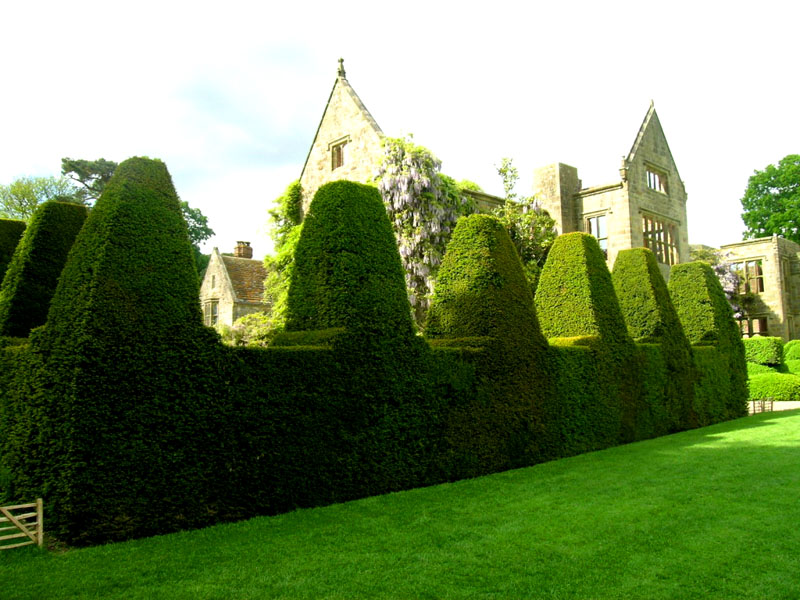
There are a number of requirements that are put forward for plants used as a living fence:
- With a large length of the hedge, it is worth choosing unpretentious plants. If you choose a shrub that requires careful care, then, processing hundreds of bushes, any desire to take care of such decor will disappear.
- In conditions middle lane pay attention only to frost-resistant plants. Otherwise, you will have to plant new plants every spring, which is expensive and inconvenient.
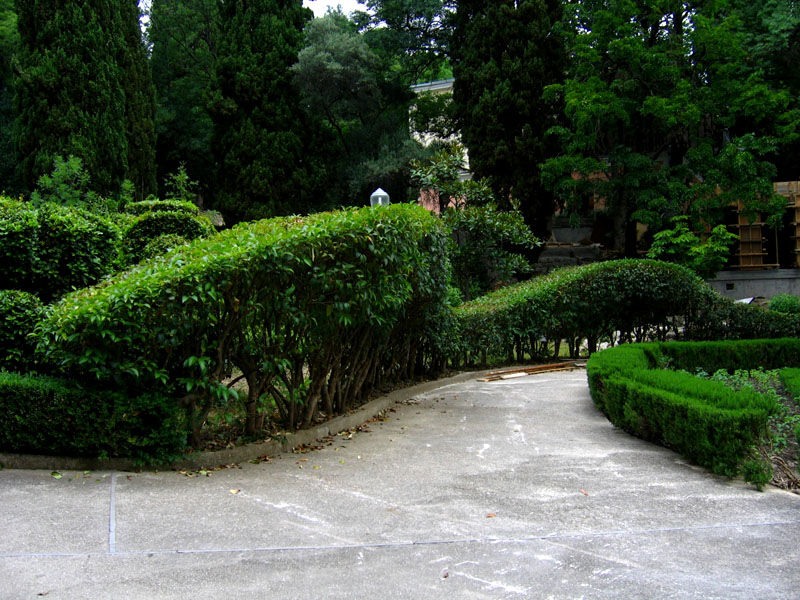
And also when choosing a live fence, pay attention to the following factors:
- how fast the shrub grows and develops;
- are there fruits and flowers;
- is it possible to cut and shape the bushes;
- how long does the decorative season last;
- no strong growth.
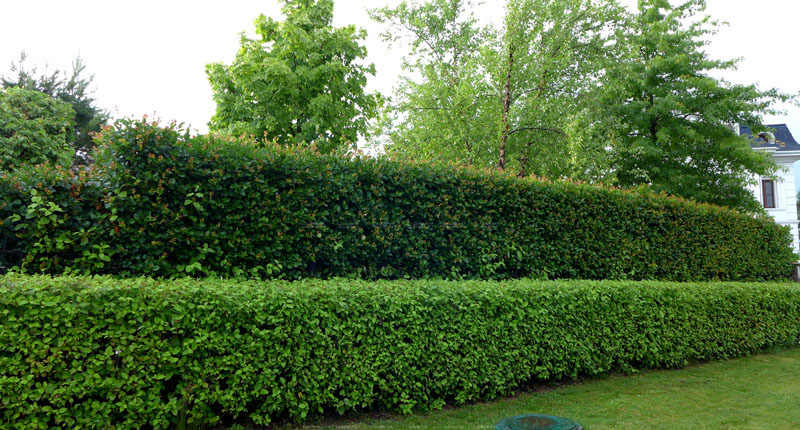
There is a special type of plant -. For them, you will need to make a fence or install trellises. This type of landscaping is located around the perimeter of the site, forming cascades of greenery.
Do-it-yourself hedge in the country: which plants are suitable
Based on the selection parameters, summer residents or owners of private buildings can choose a hedge from a wide range of plants. Among the suitable ones there are deciduous ones with beautiful inflorescences, coniferous ones with lush paws and curly ones that create a unique silhouette.
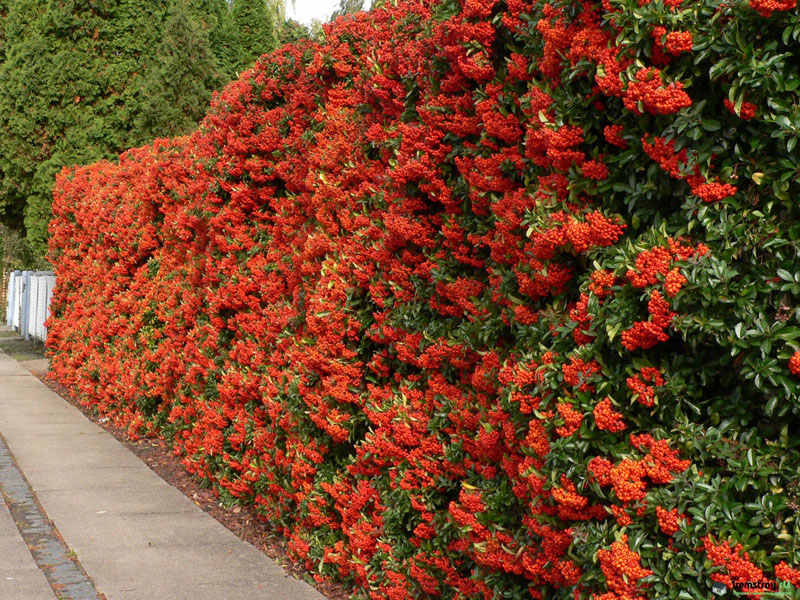
You can independently grow the following types of shrubs:
- barberry;
- periwinkle;
- euonymus;
- privet;
- hawthorn;
- honeysuckle;
- kampsis;
- cotoneaster;
- cypress lawson columnaris;
- Cupressocyaparis Leylanda;
- laurel cherry;
- holly;
- fir;
- ivy;
- boxwood;
- thuja Brabant.
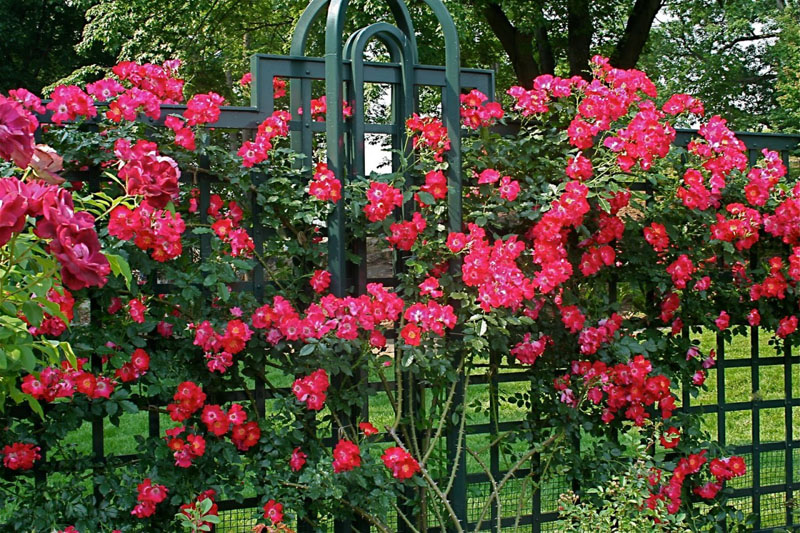
All these plants are able to create a dense crown to close your site from prying eyes or divide a large area into recreation areas. We will analyze in more detail the landing and care of each type, so that it is easier to make a choice.
Related article:
Photos and other materials from this article will simplify the adoption right decisions. They will help to accurately implement the most daring ideas, eliminate errors and not exceed the established budget.
Photos and names of fast-growing plants for hedges
First, let's look at what each of these plants looks like. After all, appearance plays a huge role in creating landscape design.
- Barberry- plastic plant. From it you can form or high fences. Suitable for cutting, so you can give the bush any shape.
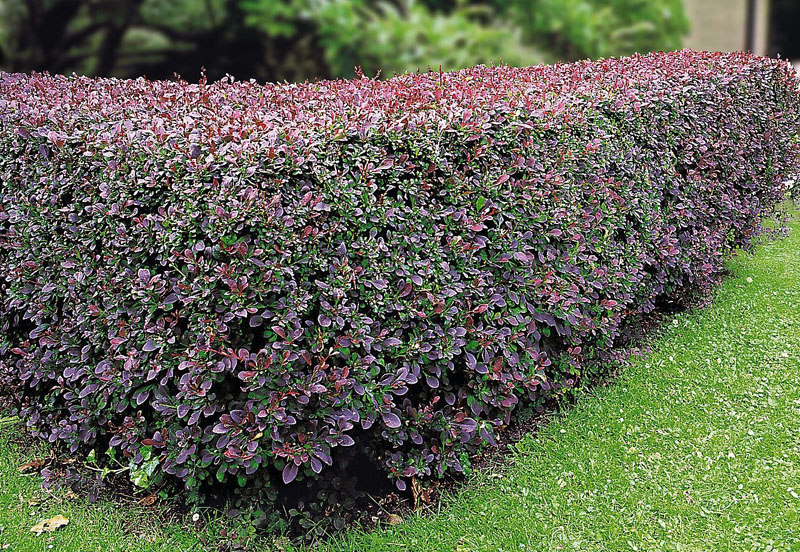
- periwinkle- an evergreen climbing subshrub. It reaches a height of 1.5 m. The stems and leaves are distinguished by their endurance and retain their beautiful appearance for a long time. The flowers are large, blue or blue.
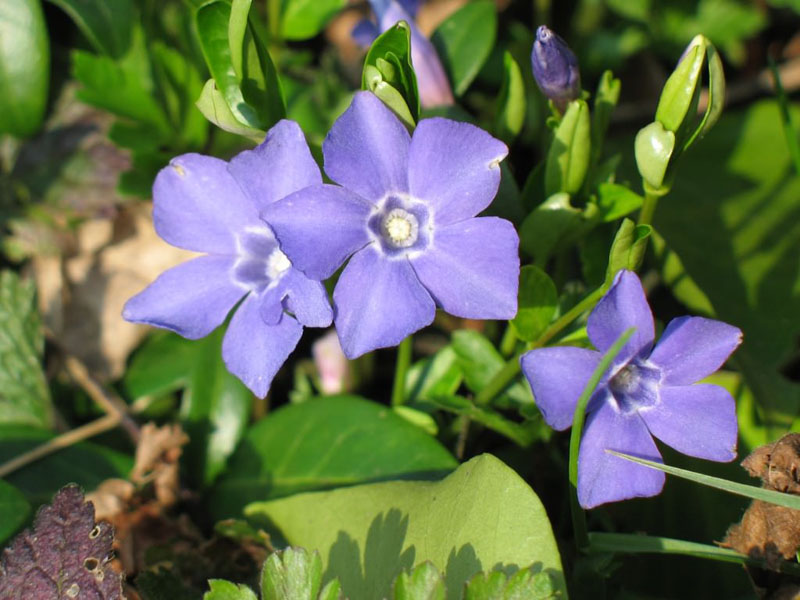
- Euonymus- has many varieties, including a curly version. Particularly popular are Fortune, Blondie or Sunspot, which have decorative foliage colors.
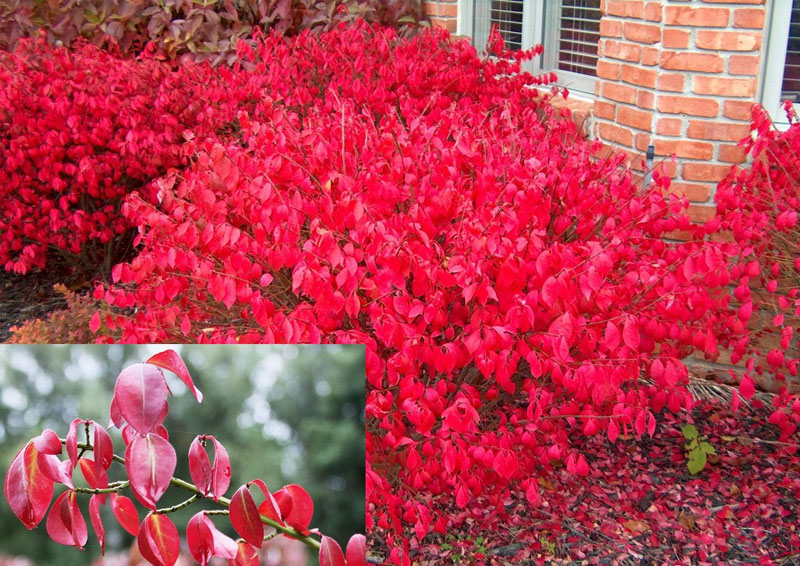
- Privet- A fast growing shrub. Blooms in early summer, but not for a long period. Suitable for southern regions: does not tolerate frost. In height more than 2 m does not happen.
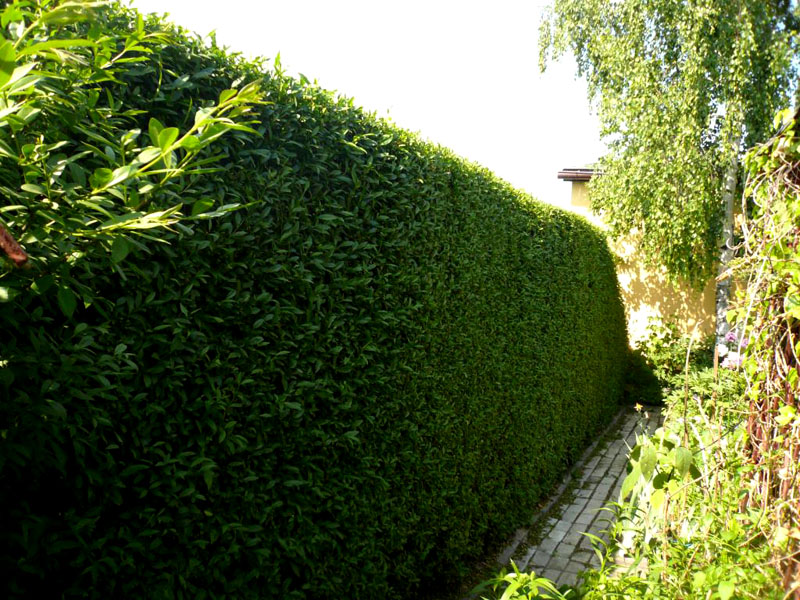
- Hawthorn- shrubs are often used as a hedge. In addition to the protective properties, the plant has edible fruits that are medicinal for the cardiovascular system.
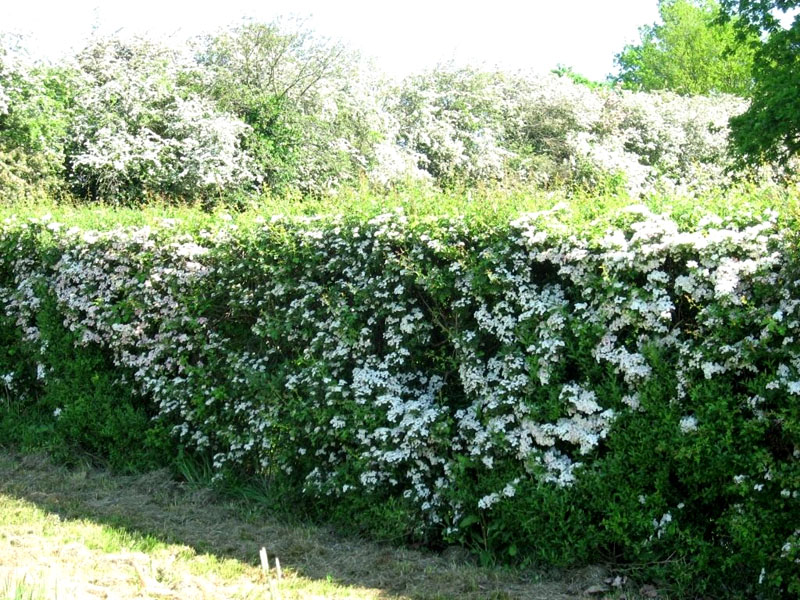
- Spruce- coniferous tree, which is often used for decoration. It is unpretentious, easy to care for and resistant to any frost.
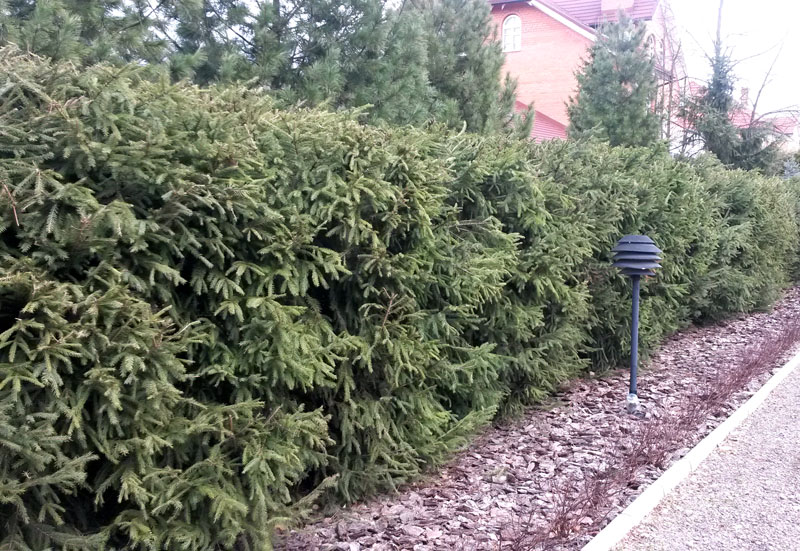
- Honeysuckle- has many varieties, is not demanding on the soil, and it is better to place the plant in partial shade. Resistant to frost, which is important in central Russia.
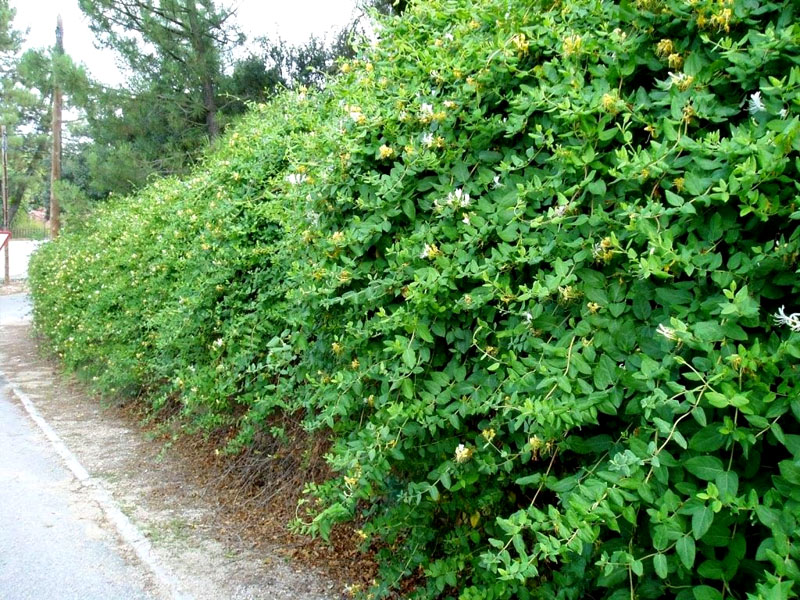
- Willow- a tree with falling foliage. It has been recently used as a living "fence", but has already become quite popular. Willow is frost-resistant and easily propagated by cuttings.

- Campsis- perennial bright liana. It is unpretentious in leaving, quickly grows. Even a novice summer resident can create such an element of decor.
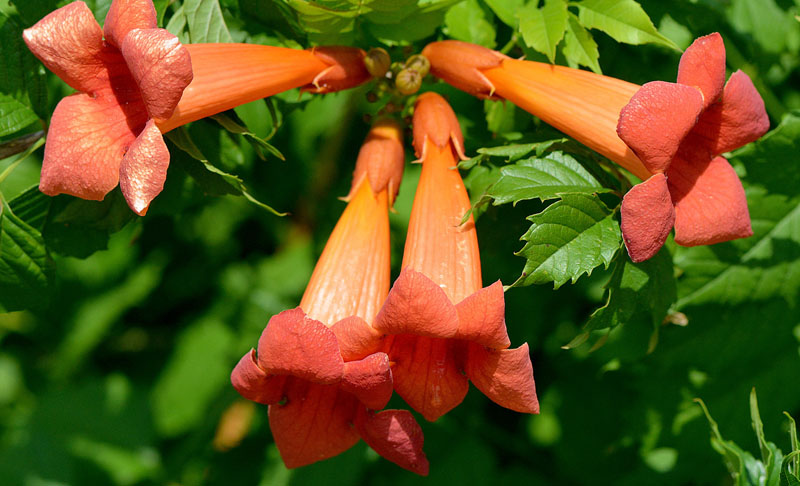
- Cotoneaster brilliant- there are different types: deciduous or evergreen. They have glossy foliage and small flowers. Resistant to frost and not whimsical to the landing site.
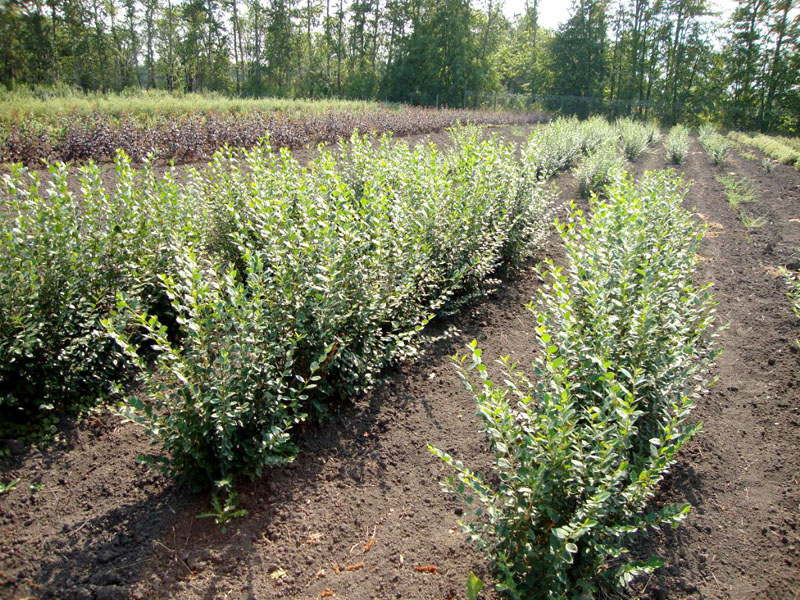
- cypress lawson columnaris – coniferous plant. It reaches a height of 5 to 10 m, a crown diameter of 2 m. The shoots are vertical and tight. Plants can be spaced closely together to create a dense and even hedge.
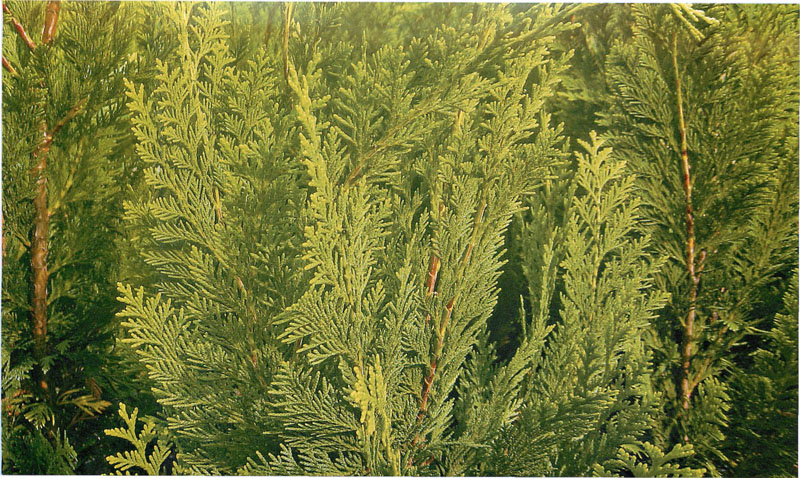
- Cupressocyparis Leylanda- a coniferous plant that should not be planted on clay soils. Suitable mixture of earth with peat or sand in equal proportions. To form a hedge, plants are planted at a distance of 20 to 50 cm.
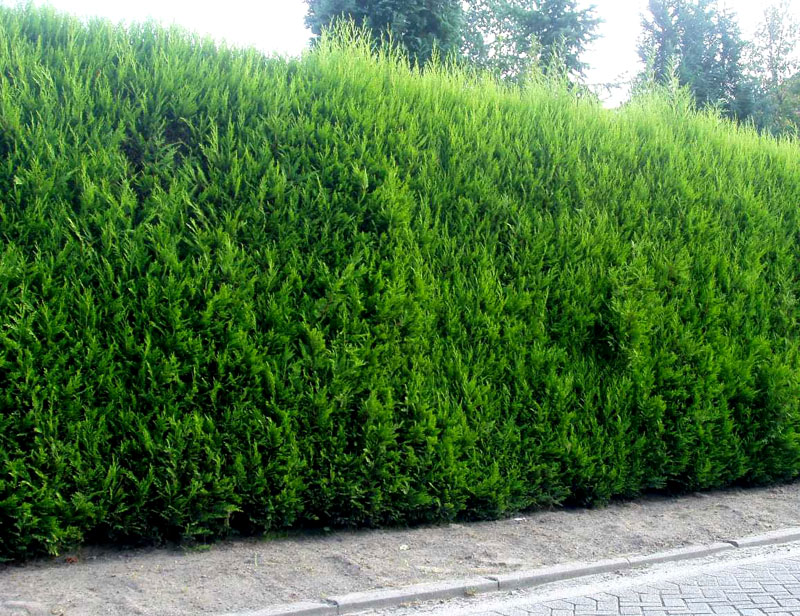
- laurel cherry – perennial shrub. It loves shade and can withstand frosts up to 25 degrees. A fast-growing variety is medicinal laurel cherry, other options grow slowly. Planted at a distance of 50 to 70 cm.
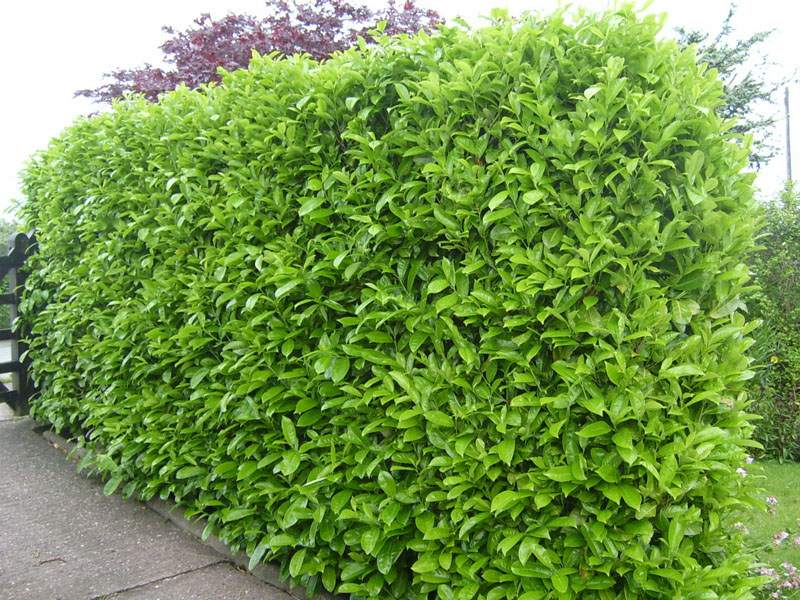
- Holly- an evergreen plant, up to 3 m high. Likes partial shade and nutritious soil. You can not plant in cold regions, and you can cut it no more than once a year.

- Balsam fir- an evergreen plant. Dislikes city life: exhaust fumes have a bad effect on growth and color. Suitable for the middle lane and tolerates frost.
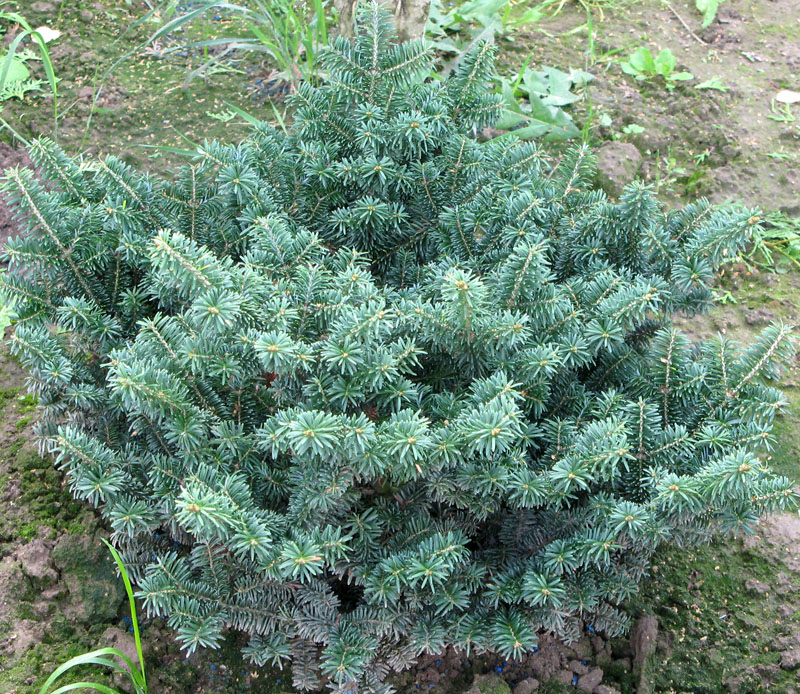
- garden ivy- a climbing plant that is planted next to an ordinary fence. It beautifully braids the design, making it unusual and green. It is unpretentious in care, but do not forget about safety and work with the plant with gloves.
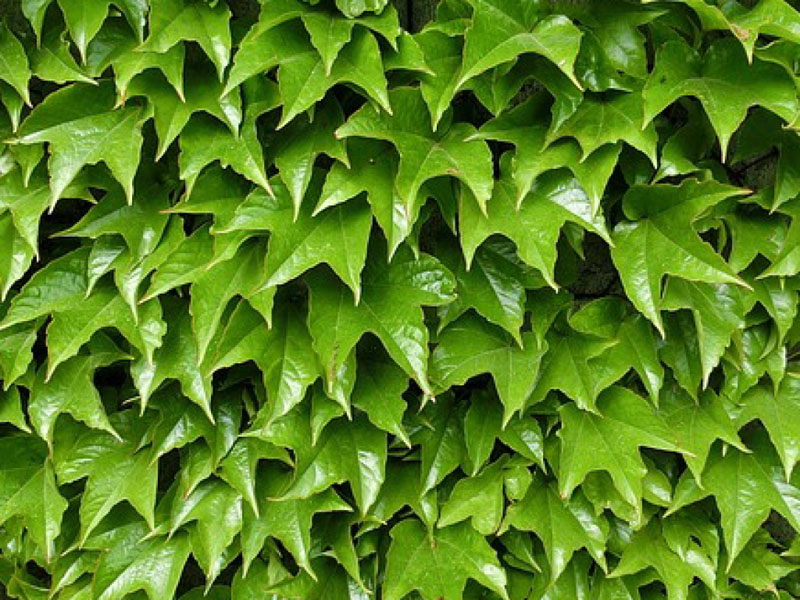
- boxwood- evergreen shrub with long leaves (3 cm). Well suited for landing in the middle lane, and the highest life expectancy reaches 500 years.

- Tuya Brabant- Belongs to the cypress family. There is another name - "tree of life". The evergreen plant is drought tolerant and is hardy and highly resistant to various diseases. You can cut twice a year.
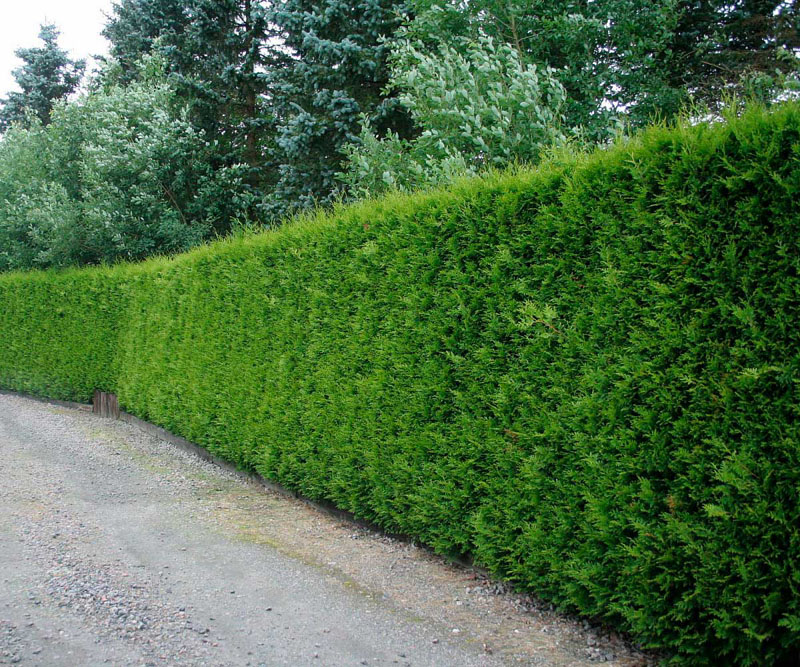
- Thuja smaragd- decorative variety of coniferous tree. It has a pyramidal shape, so the plants can not be cut at all. It reaches a height of 10 m, a width of 2 m.

There are other options ornamental plants, which are used to create hedges. The above list is considered the most common for planting and easy to care for. How to properly plant and cut shrubs and trees, we will consider further.
Evergreen barberry: planting and care
Barberry is not just a beautiful evergreen plant used to create an interesting landscape design, but also a healing shrub with edible fruits. Yellow paint is obtained from bark or wood in industry, and berries contain a lot of citric and tartaric acid. They make sweets, jams and other sweets.
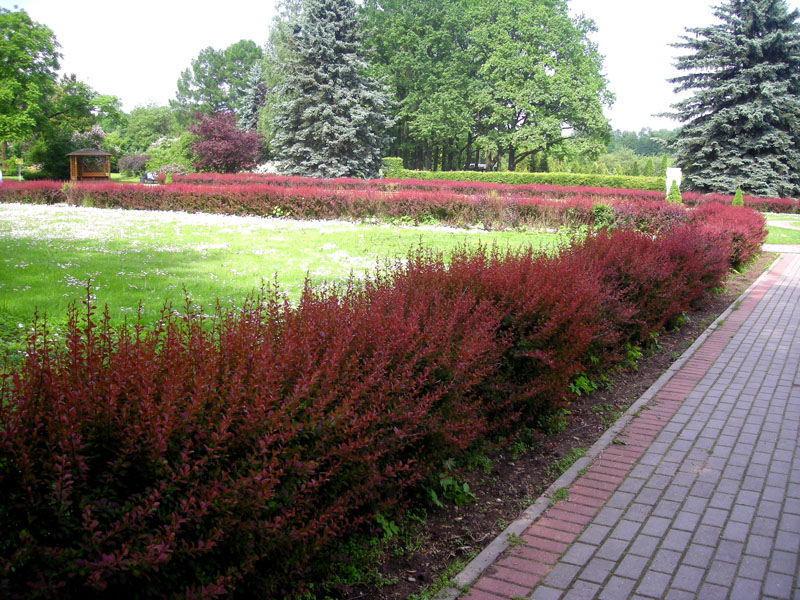
reproduction
Shrubs can be propagated in several ways:
- Cuttings. They are cut and germinated in a greenhouse, you can simply dig up with plastic wrap. As necessary, young shoots should be aired after the first leaves appear. The soil around the landing should be loosened.
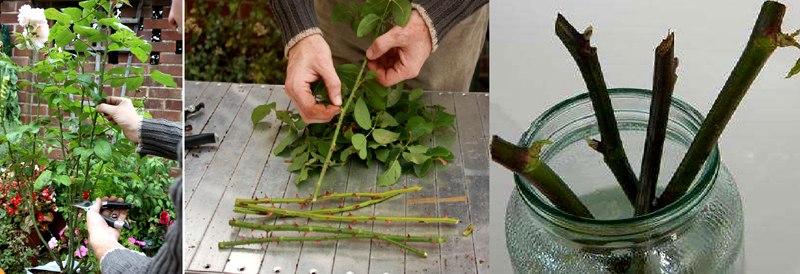
- Seeds. You should choose well-ripened berries. Then, separate the bone from the pulp and treat with a weak solution of potassium permanganate. Sow in autumn in prepared soil before frost. If you want to plant in the spring, then for the winter, place the seeds in soil mixed with sand and leave in a cold place. After six months or a year, shoots will appear from the strongest seeds, which are transplanted to a new place. The plant begins to bear fruit 2-3 years after germination.
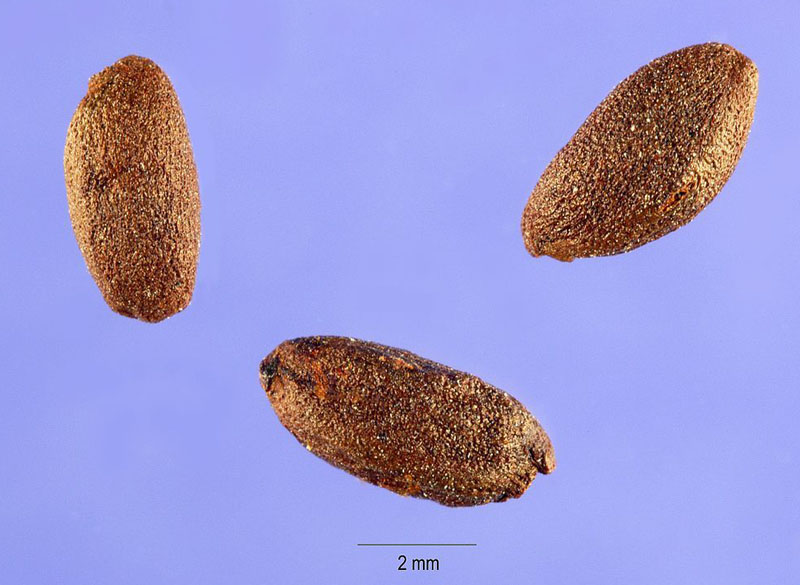
- layering. You choose annual branches on a growing bush, make grooves near the trunk, when the soil dries out, fix branches in them to a depth of 20 cm. Only the top of the shoot is left on the surface.
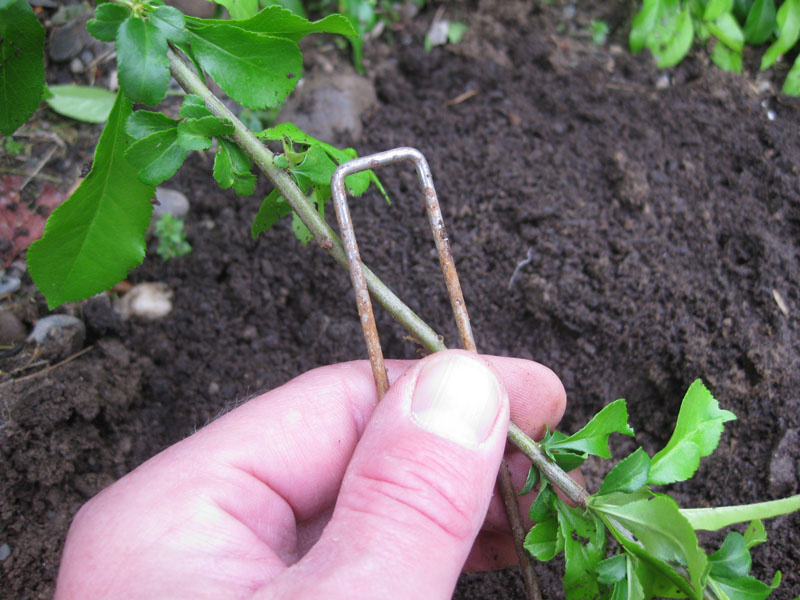
- The division of the bush. Carefully dig and cut the root system of the bush. Be careful not to damage the roots.
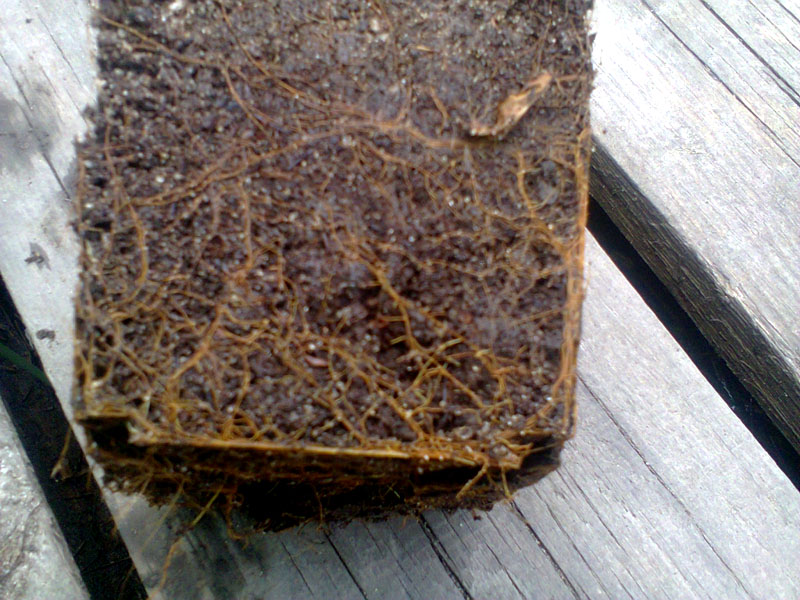
The easiest way is to dig in young branches. You will get a dense hedge by gradually planting the plants in the right direction.
shrub planting
Barberry is unpretentious to the type of soil. It can grow in both normal and highly acidic soils. If on your site the acidity index exceeds all norms, then before planting the plant, add a mixture of lime and earth to the pit. You need somewhere around 400 g of slaked lime and 200 g of wood ash.
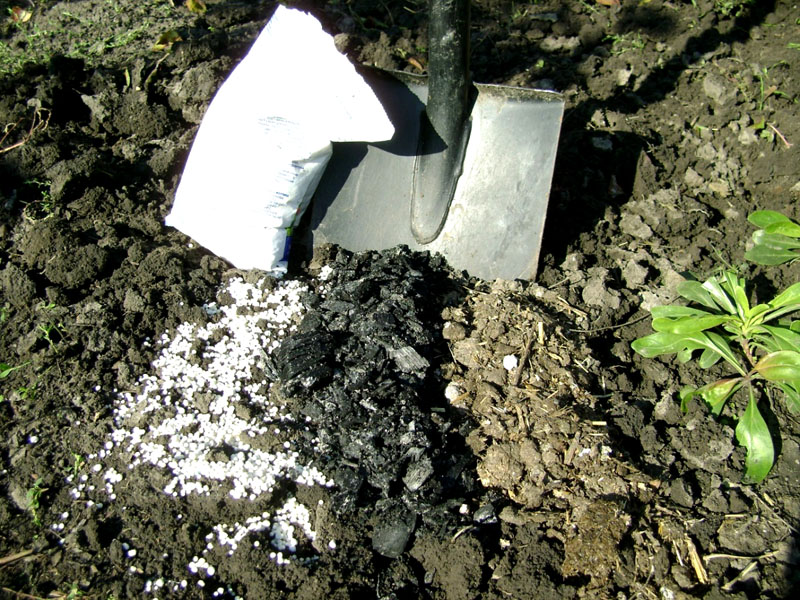
To obtain a hedge, bushes are planted at the rate of 2 plants per 1 running meter. The choice of a sunny or shady side is not critical, as the shrub easily adapts to different environmental conditions.
Summer residents and owners of private houses choose barberries for a reason. It is unpretentious in care and at the same time has a beautiful appearance with edible fruits. Here are some plant care tips:
- once every seven days;
- mineral fertilizers are applied once in the spring, a year after planting;
- loosen the soil often;
- after decorative pruning, remove weak shoots and broken branches;
- You can only cut in June or August.
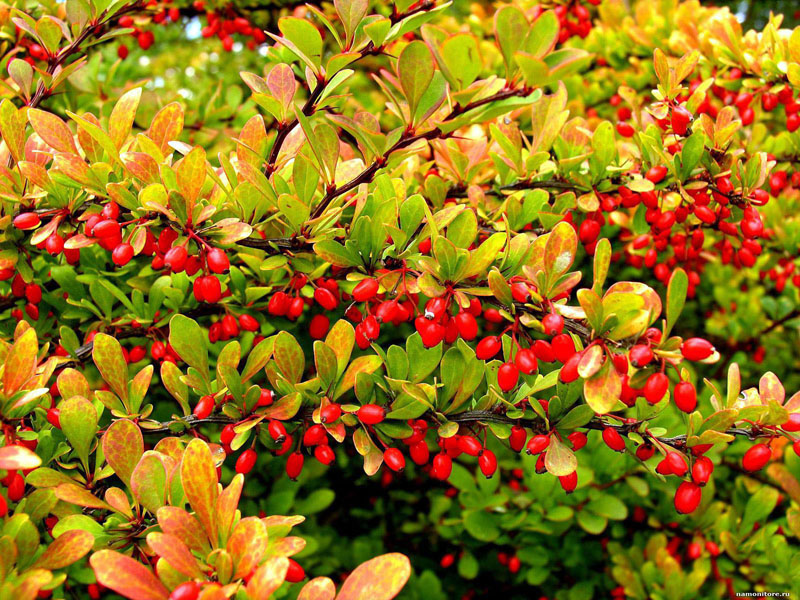
Periwinkle: photo of flowers, and how to care for the plant
An interesting plant with beautiful flowers. It is unpretentious in care, so it is suitable for growing even beginner gardeners. The flower consists of five petals of a pale purple or blue hue.
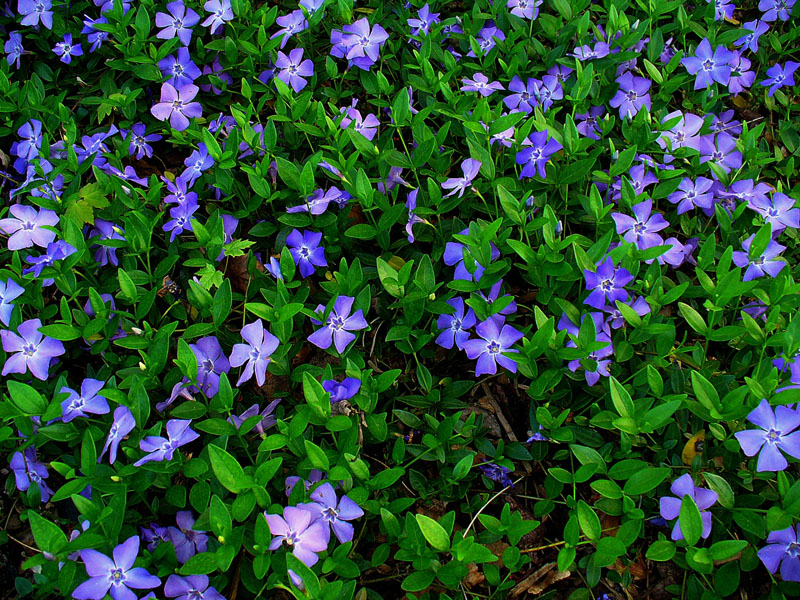
Cope with periwinkle planting and care in open field everyone can. The plant of the selected variety takes root on any soil, it can be planted on the slopes of the plots. The shrub is actively growing, therefore, when disembarking, a distance of 30-35 cm is observed.
You can plant on any soil with a sunny or shady side. In the early stages of growth, it is worthwhile to ensure proper watering, then, the plant does without abundant moisture. In summer, it is enough to water the hedge once every 7-10 days.

Periwinkle does not need subcortex. And it can be propagated by cuttings, seeds, dividing the bush or branch. The easiest way is division, since active growth begins immediately after reproduction.
Advice! Plant the shrub in spring or early autumn, in summer the soil will not be moist enough for the successful growth of a new plant.
Beautiful flowers can also be used as separate elements of landscape design; periwinkle looks good in flower beds in flower arrangements. Here is a video on caring for this plant:
Euonymus: planting and care in the open field
Euonymus is a woody plant, low and evergreen. Use it to create hedges, decorate fences or decorate the site. A single plant looks good on an emerald lawn.

There are about 200 species, each of which looks beautiful and original.
Important! The berries of the bush are poisonous, if there are children, make sure that they do not eat them, despite the fact that they are eaten by birds.
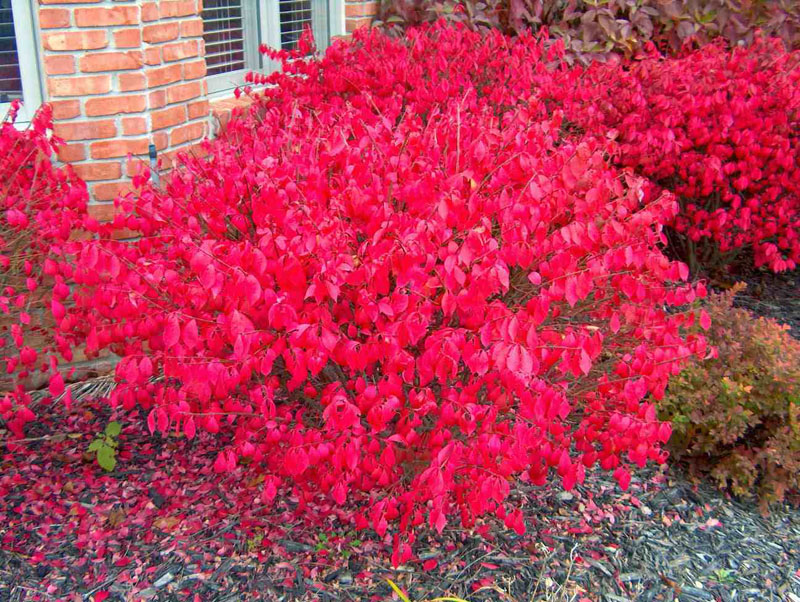
Propagated most often by branches or division of the root system. Rarely use seeds or cuttings. It is important to treat seeds with a solution of potassium permanganate and plant them in autumn to a depth of 2 cm.
Soil selection, planting sites and care
| soil type | Suitable for slightly alkaline rocks. If the soil acidity is increased in your area, then a mixture of lime and ash should be added to the soil before planting. |
| Place to land | The plant grows faster in width, so plant a hedge at a sufficient distance from other trees. |
| Care | It does not tolerate frost, so it should be covered for the winter, and the soil around the trunk should be covered with fallen leaves. In the summer, in the heat, it requires increased watering. |
| pruning | You can prune several times during the summer, while removing dry branches and broken shoots. |
| Pests | Subject to attack by caterpillars, aphids, mealybugs and molds. They are processed in the same way as fertile trees in a regular garden. |
Privet - a hedge for your site
Privet is a common element of landscape design. Refers to the role of olive and evergreen shrubs. It occurs naturally in the undergrowth. The plant is not whimsical to the ground, tolerates drought and frost well. Suitable for landing in central Russia.
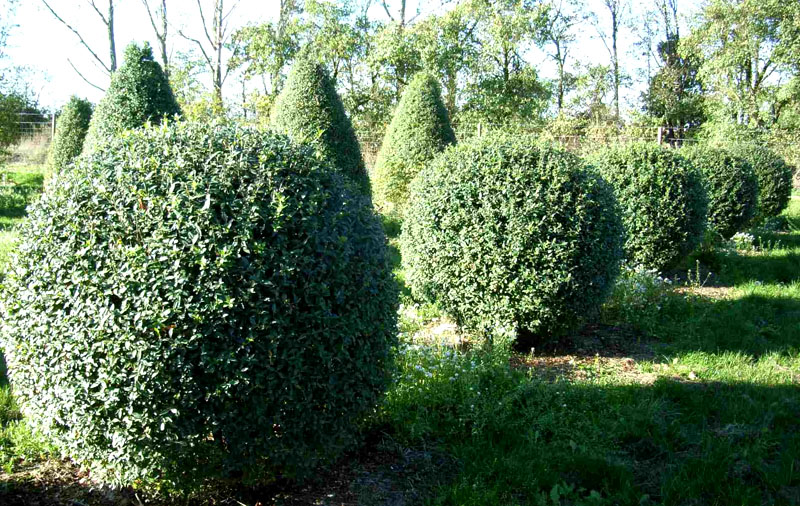
Privet takes root well in the city and the countryside, the shrub is not affected by exhaust gases or atmospheric pollution. Grows well in open and fairly moist areas.
For planting single bushes, pits are dug 40 cm deep. To create a hedge, add a substrate (earth mixture) from ash (300 g per linear meter) and lime (150 g) to the trench, and also include mineral fertilizers in the amount of 70 g.
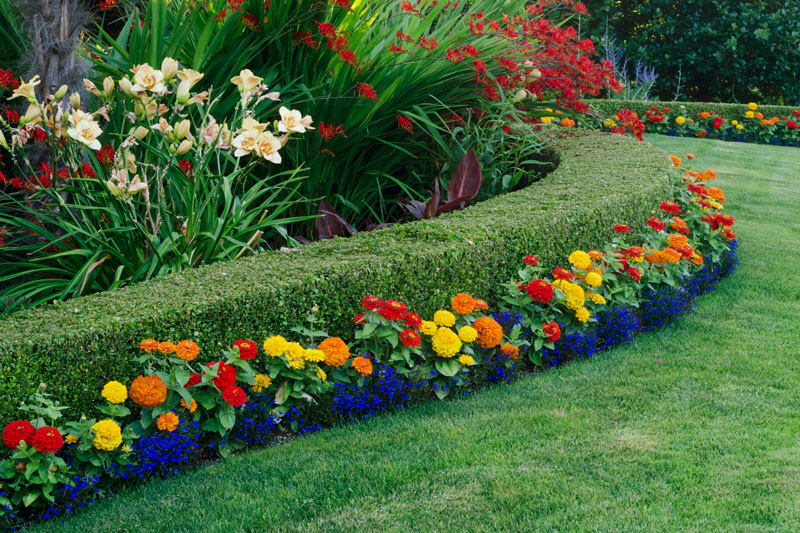
Plant plants on the sunny side, as it comes from southern countries. And the care complex includes watering, which is especially important for young shoots, fertilizing with mineral fertilizers in spring and pruning. Even if you don't specifically shape the hedge, you should keep it sanitary.
It is best to propagate by branches or cuttings. You can use seeds or division of the rhizome. Here is a video on care and reproduction:
Long-lived, undemanding plant - hawthorn. Able to bloom and bear fruit from the age of 10-15 years. It does not require special care and is perfect for creating a hedge in central Russia.
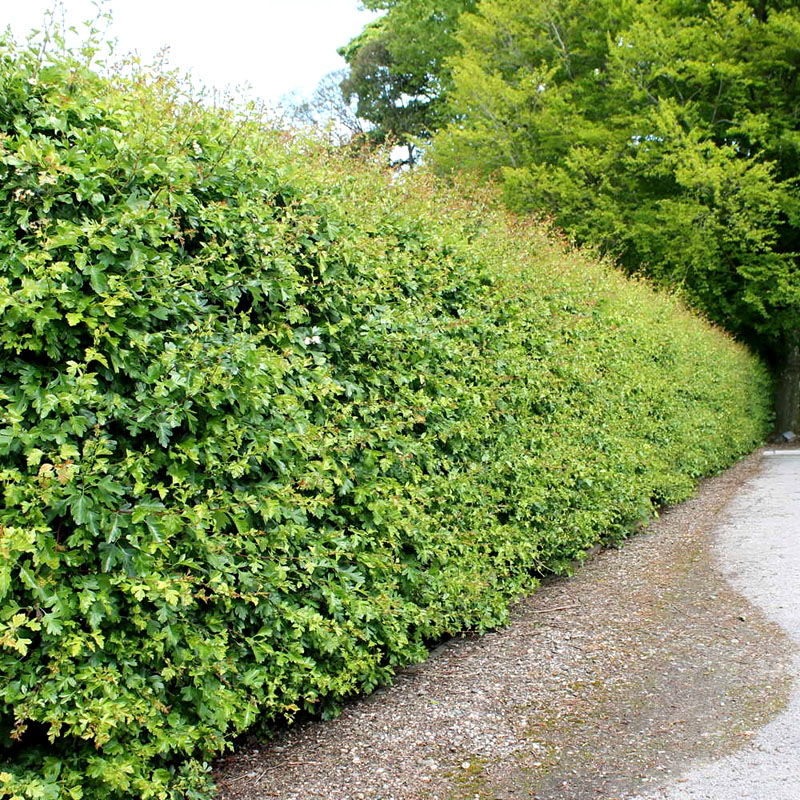
The root system is deep, so you can only transplant up to 5 years. He loves the sun, in the shade it bears fruit and blooms worse. Grows on any soil. And it is best to propagate by cuttings.
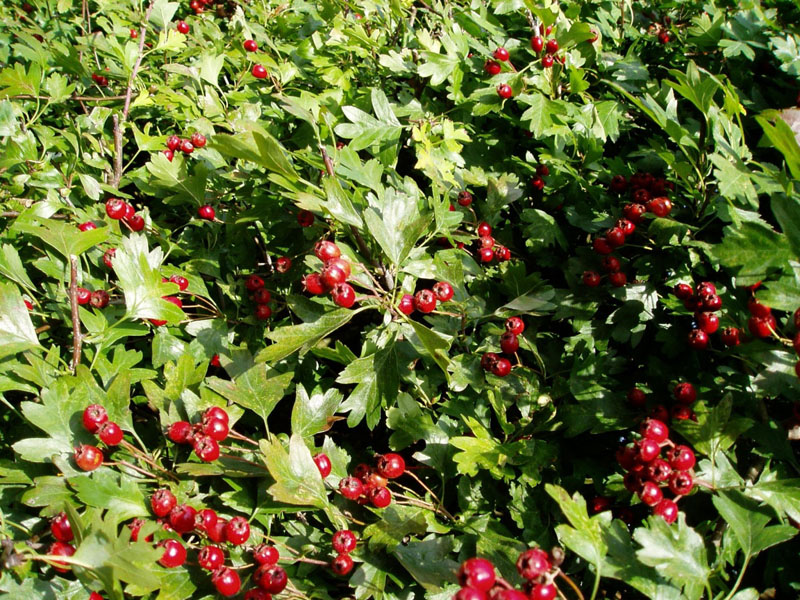
To give the hawthorn hedge density, cut the plants and plant them at a distance of 10-15 cm. Use a trench, up to 1 m deep. In the first year of life, all shoots are cut at a height of 15 cm. In summer, you can shorten the lateral branches to stimulate growth. In the second year, the main branches can be cut in half, and the side branches shortened again. And on the third, proceed to the formation of the desired shape, conducting a “haircut” 4-6 weeks before September.
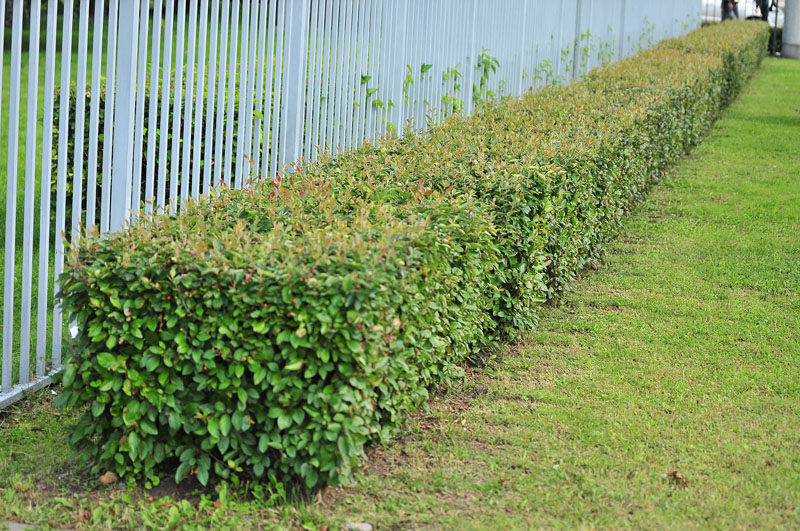
Here is a video on the features of caring for this decorative hedge and growing the bush itself:
spruce hedge examples
Norway spruce is the most common plant in the middle lane. She has not only external beauty, but also an indescribable smell of pine needles. On the site, such trees look great, well cleaning the air from pollution.
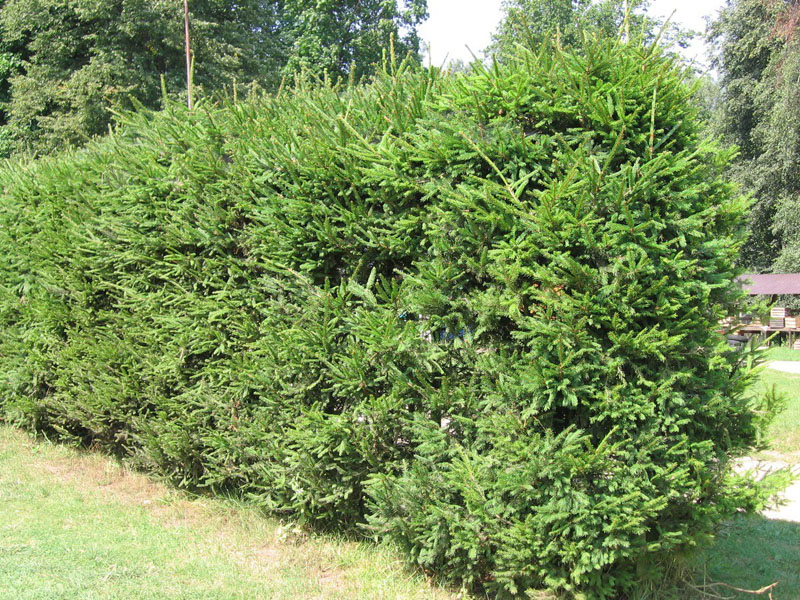
So that it does not reach its natural height of 50 m, it should be cut. Planted in a trench with a depth of 0.5 m and a width under the root system. Spruces do not like an abundance of moisture, so you should create a drainage layer in the trenches, filling the bottom with crushed stone or expanded clay by 20 cm.
To prevent the root system from drying out, the roots of the seedlings are lowered into the clay mixture before planting on the site. Shearing in the first year of life is impossible. Otherwise, the tree does not need special care, except for regular treatment from pests such as aphids, caterpillars or spider mites.
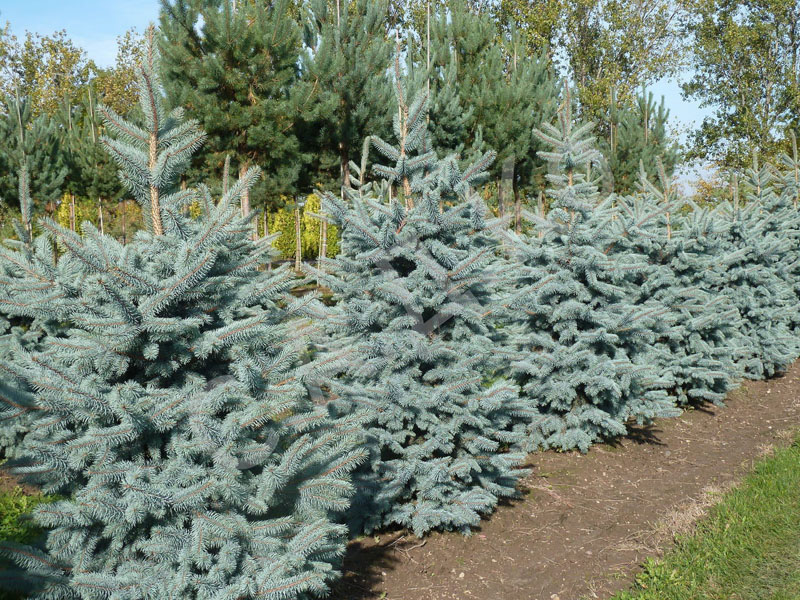
Here are photo examples of beautiful hedges and landscape design options with spruce:
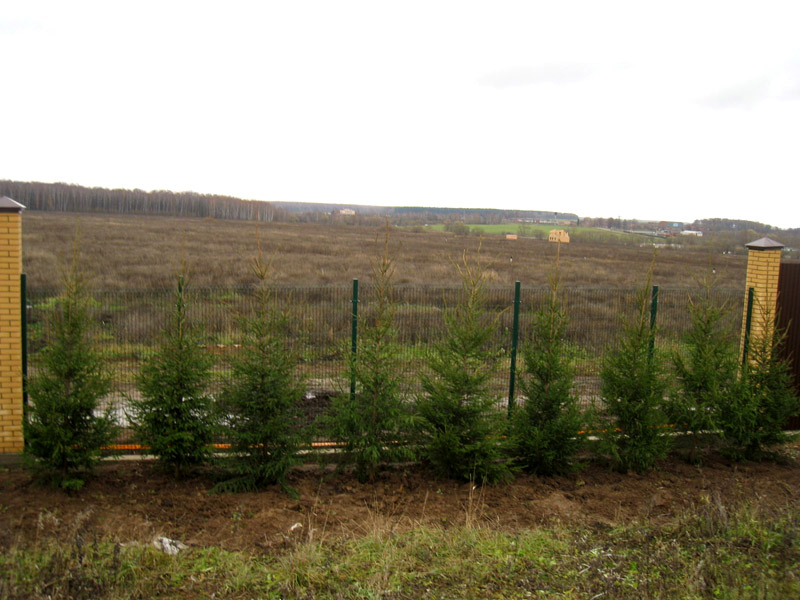
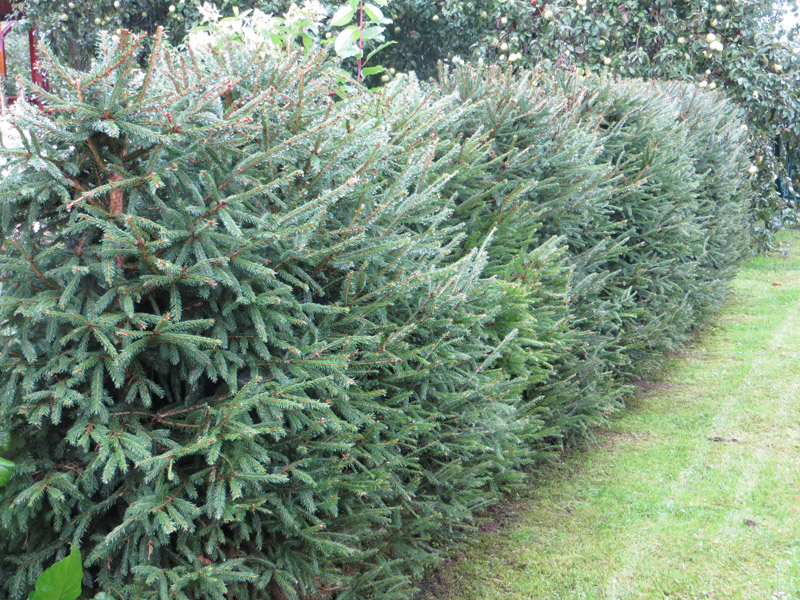

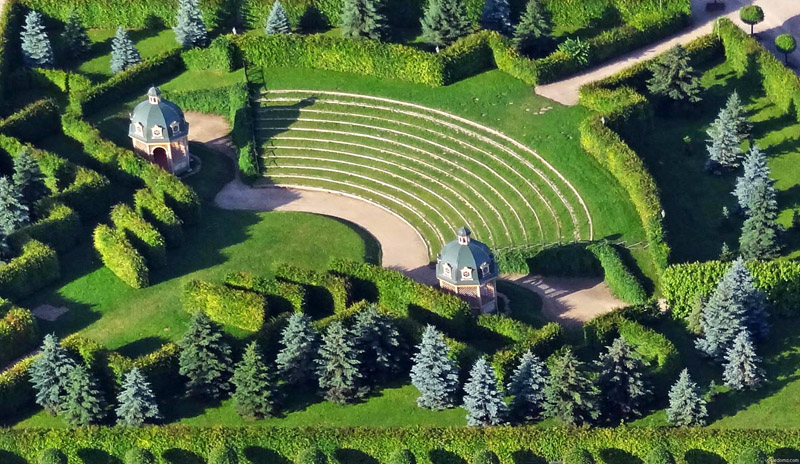
Honeysuckle honeysuckle: planting, care, plant photo
The honeysuckle honeysuckle variety is an unpretentious plant suitable for any type of mail. It blooms luxuriantly in the sun, and is best planted in October.
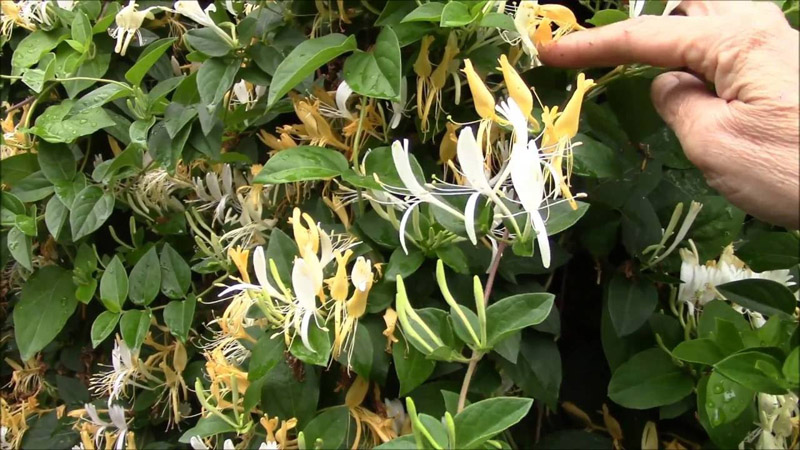
For planting, prepare a hole 0.5 m deep and add humus and wood ash to the bottom. Make sure that when planting, the root system is 5 cm below the soil level. After digging in, the soil around should be covered with peat in a 3 cm layer.
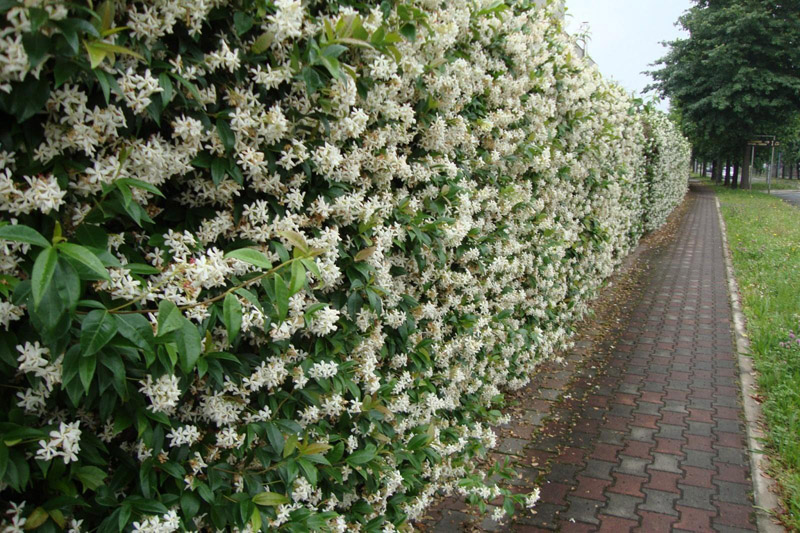
The plant is not afraid of frost, so it is perfect for the middle lane.
Important ! When cutting old shrubs, leave stumps 30-40 cm in height, otherwise the entire root system may die.
After rejuvenation, the shrub can grow strongly, then thin out the next year, leaving 10-15 of the strongest branches. Here is a video on proper care and planting of a plant:
Willow hedge: planting features
Willow fences are becoming more and more common. Its beautiful branches falling like a waterfall attract attention, and often planted trees allow you to close the area from prying eyes.
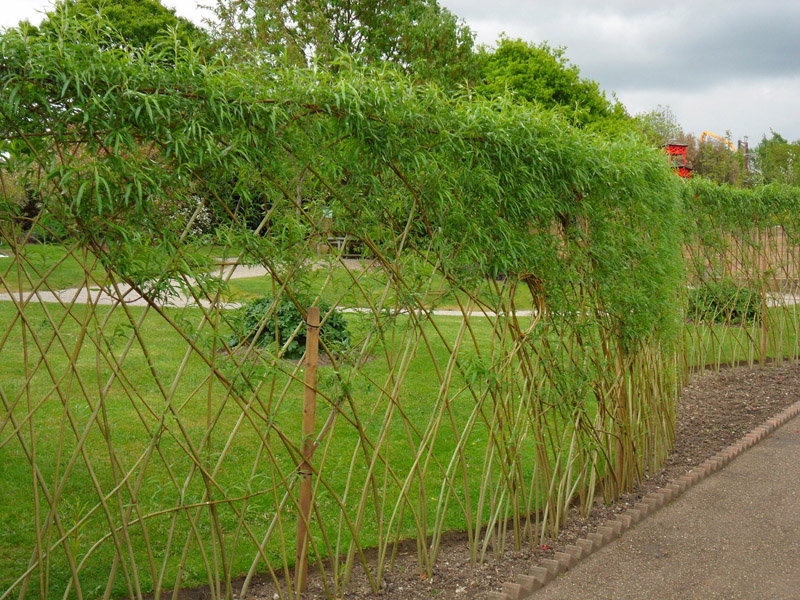
To create such a living barrier, cuttings harvested in autumn or spring are best suited. It is best to use annual shoots that are cut in the fall and stored in a cool room.
You can buy ready-made seedlings, paying attention to their root system, which should not be dry. Cuttings easily take root in any moist soil, but acidic soil is recognized as the most suitable.
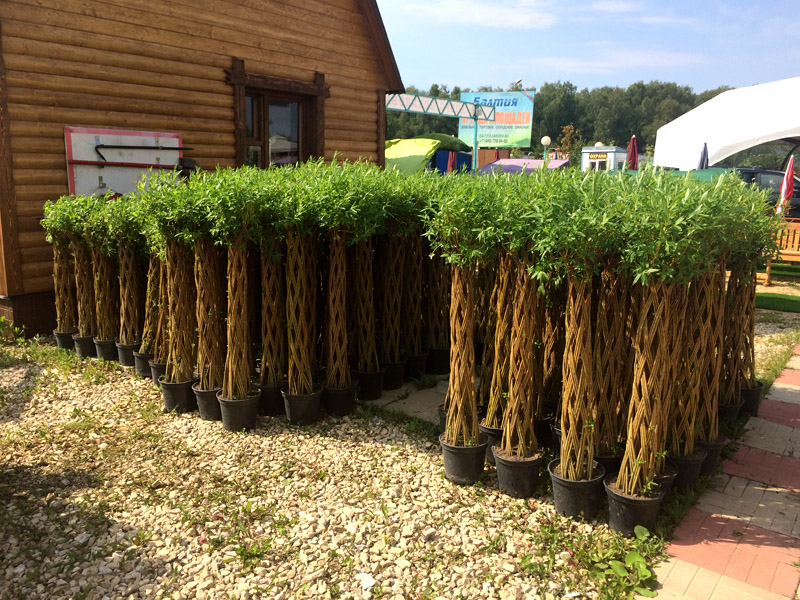
To create a living fence, mark the perimeter of the site. Dig a trench 40-50 cm deep. It is necessary to plant the shoots next to the driven pegs, since the seedlings will need a frame. It is necessary to plant at a distance of 20 cm and at an angle of 45⁰.
The plant is fed 2-3 times with complex mixtures, and at the end of summer, potassium sulfate is added to the soil. With proper care, such a fence will last up to 50 years.
Campsis large-flowered planting and care in the open field
An amazingly beautiful liana that grows rapidly and braids the selected section of the fence.

When planting, one nuance should be taken into account - the root system is actively developing and filling all the nearby space. When planning a planting, consider how to protect other plants from the aggressive roots of Kampsis grandiflora. For example, put in a narrow passage between buildings.
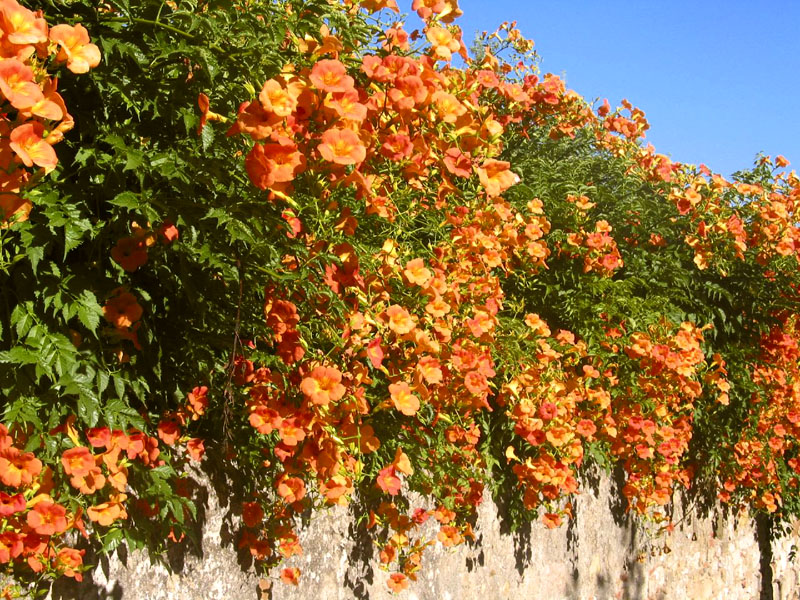
The plant loves a lot of heat and sun, and for good growth the soil should be loose and slightly acidic. Planted in a hole 50 cm deep, where humus and complex fertilizers are added. At the bottom, it is desirable to pour expanded clay or fine gravel.
You can plant in early April, if repeated frosts are not expected, and buds have appeared on the seedlings.
Important! Consider in advance a support for the growth of the vine.
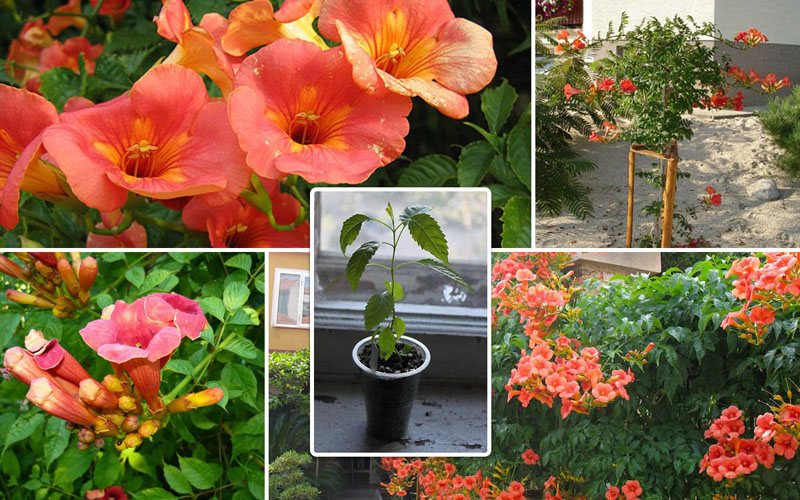
It should be watered regularly, but not allowing waterlogging. You can cut as needed, and the plant does not need to be fed at all. Below is a video on proper care and planting:
Brilliant cotoneaster - hedge: photos of interesting solutions
The cotoneaster is brilliant in planting and caring, so even an amateur gardener can handle such a hedge or plot decor option. It's upright deciduous shrub, reaches a height of 2 m, and inflorescences consist of 5-8 flowers. Begins to bloom in May. The fruits are round and berry-like.
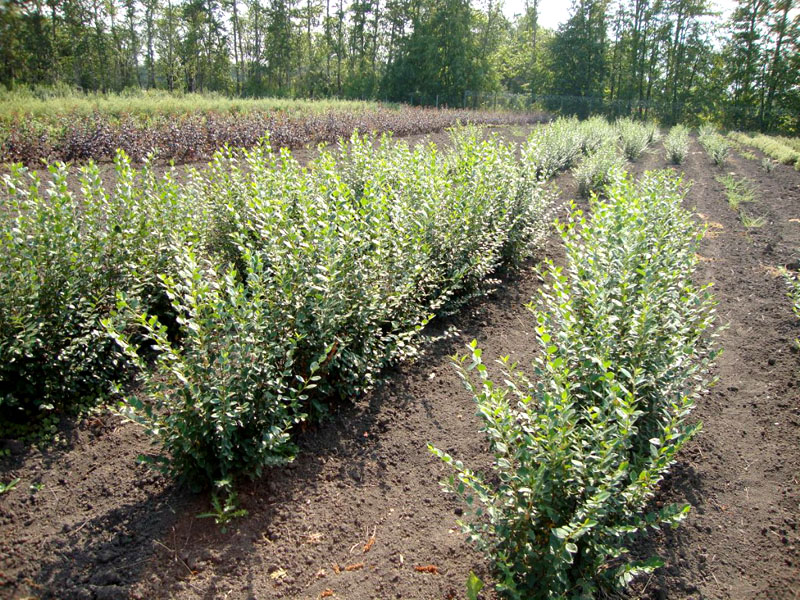
| Planting seeds | Seeds should be planted densely, not all seedlings give. It is impossible to plant a plant for the first 1-2 years, during this period they will germinate by 30 cm. |
| seedlings | They are planted at a distance of 1-2 m in a trench 60 cm deep. A layer of drainage is laid down the pit. |
| Location selection | It grows well in the shade and in the sun, but does not like strong winds. |
| The soil | Dry soil with deep water table |
| Watering and fertilizing | Feed in the spring with organic or mineral mixtures. And water the soil around the shrub during transplantation or severe drought. |
Photo examples of hedges from brilliant cotoneaster:
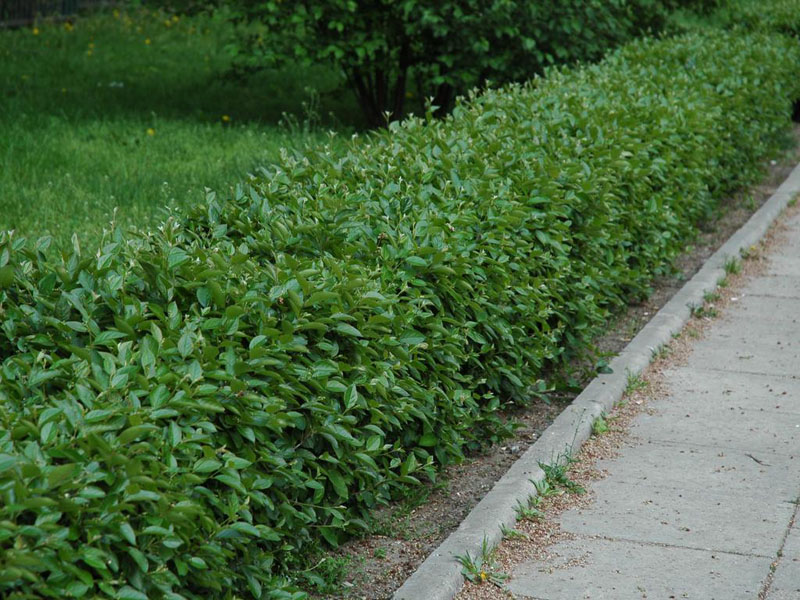
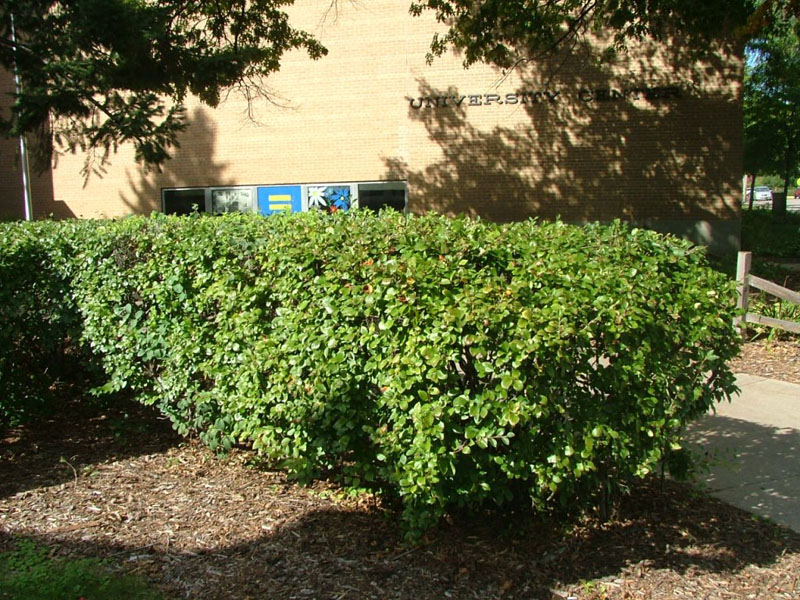
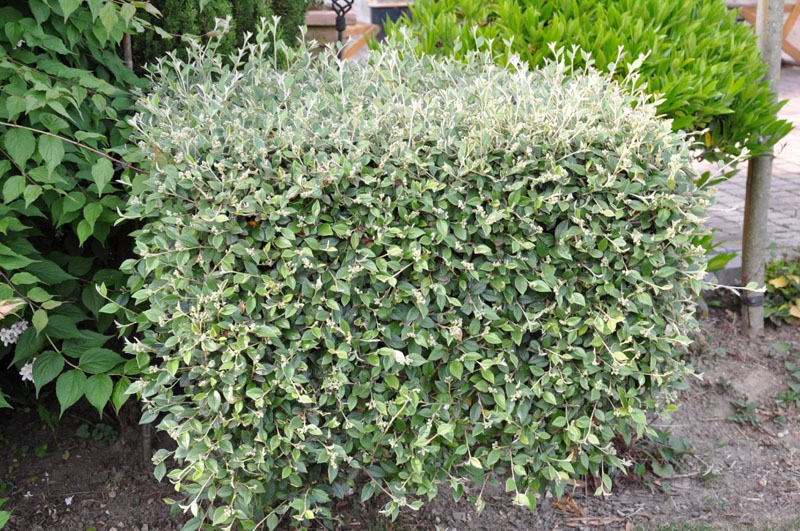
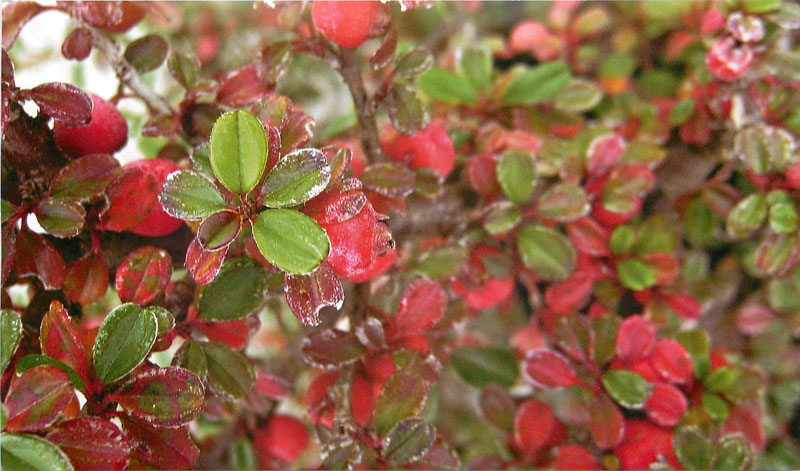
Photo cypress lawson columnaris as a hedge
Cypress lawson columnaris - low evergreen tree, unpretentious in care and suitable for creating a living "fence". It reaches a height of no more than 10 m. The root system is well developed and high resistance to frost.
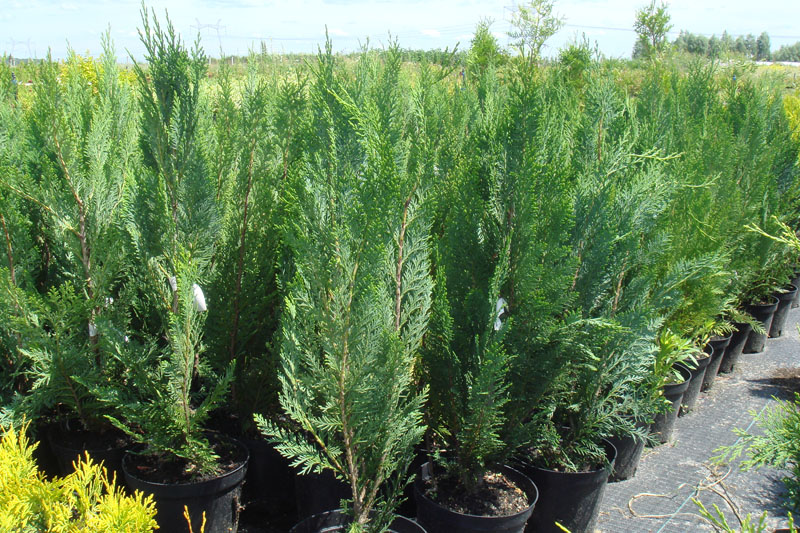
Photo examples of a green fence:
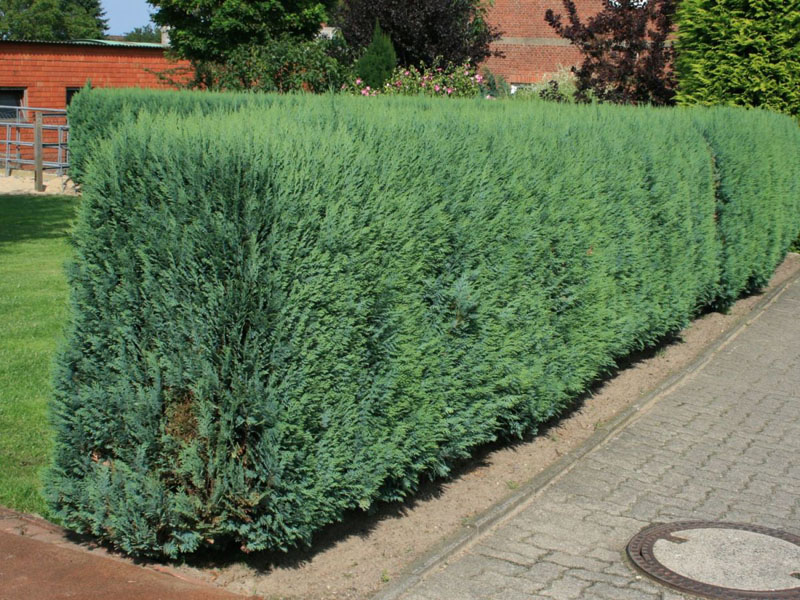
Cupressocyparis Leylanda: planting and caring for the plant
Cupressocyparis Leylanda is an evergreen cone-shaped plant. The dense crown and shoots hanging down make it possible to create a dense hedge. The size of one tree is up to 30 m in height and 3-5.5 m in width. In order to prevent such huge dimensions, the plant should be cut and rejuvenated in time.
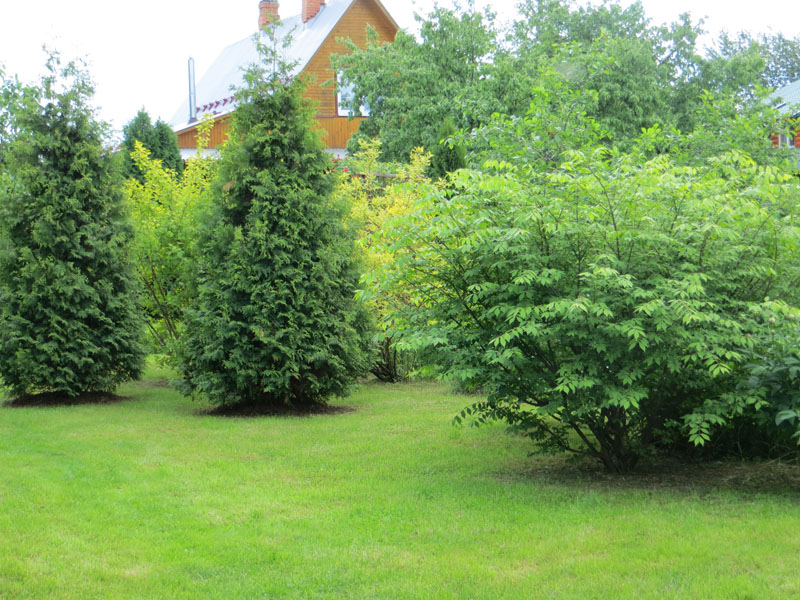
It is unpretentious to the soil and tolerates shade well. It is better to plant seedlings in a trench at a distance of 40-60 cm.
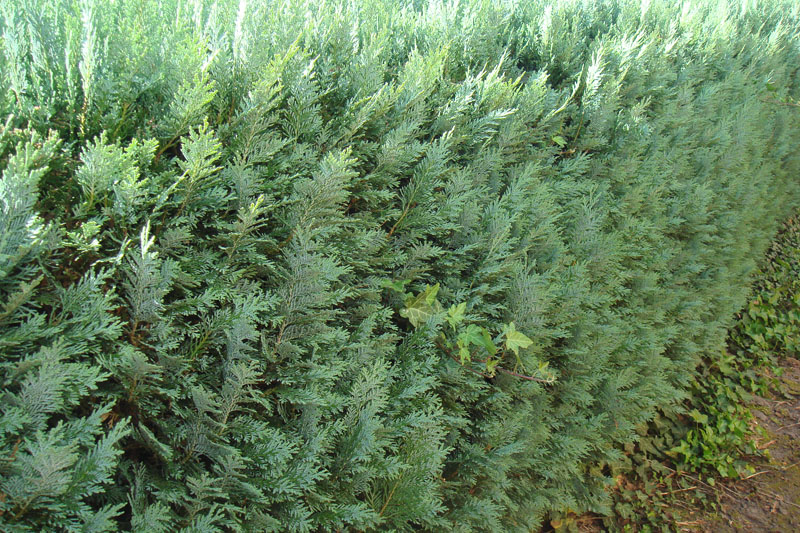
Lavrovishnya: description and photo
The option of a fast-growing laurel cherry hedge is perfect for the middle lane with severe frosts. Outwardly, this shrub is a cross between laurel and ficus.
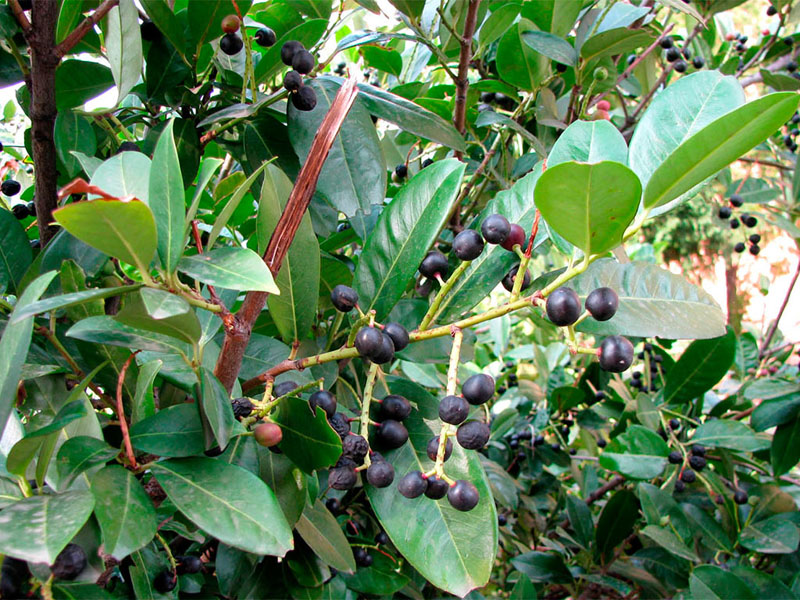
There are dwarf varieties and regular ones. The second ones reach a height of 10 m. The tree bears fruit and the berries are edible sweet in taste, but many decorative options are already deprived of the ability to bear fruit.

Special care is not required. It tolerates shade well and is practically not susceptible to any diseases and pests. Easily propagated by seeds or layering, and also sold in cuttings.
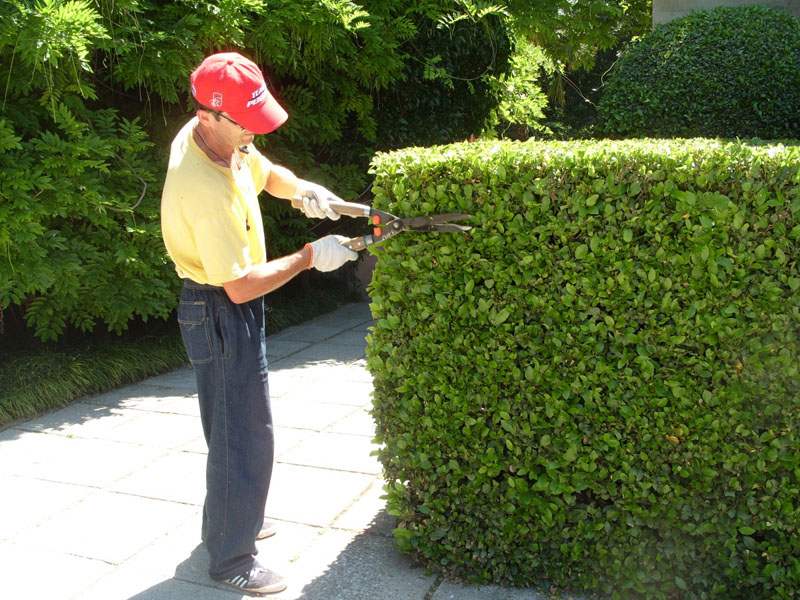
Plants lend themselves to any form of decoration: pruning, bending, entwining around the net. Therefore, it is so common as a decorative element for creating hedges.
Holly: photo planting options
Holly loves shade and moisture. The leaves are sharply toothed and the fruits are bright red. Propagated by seeds and used as a hedge or for a single decoration in combination with other plants:
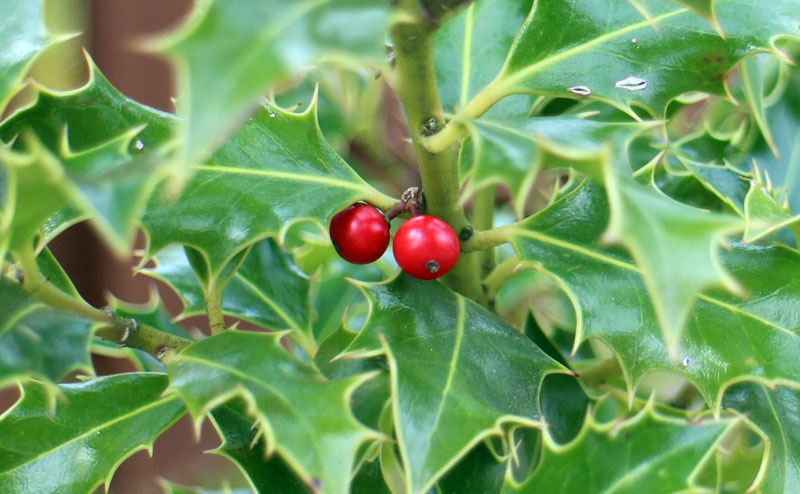
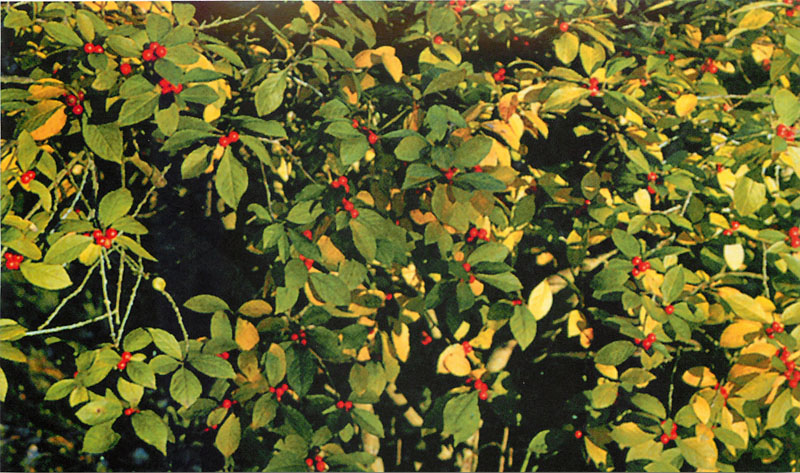
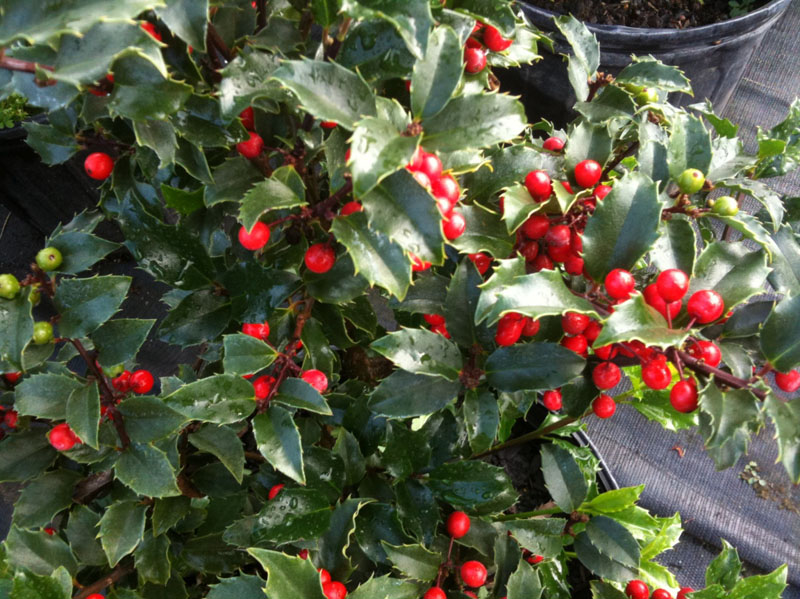
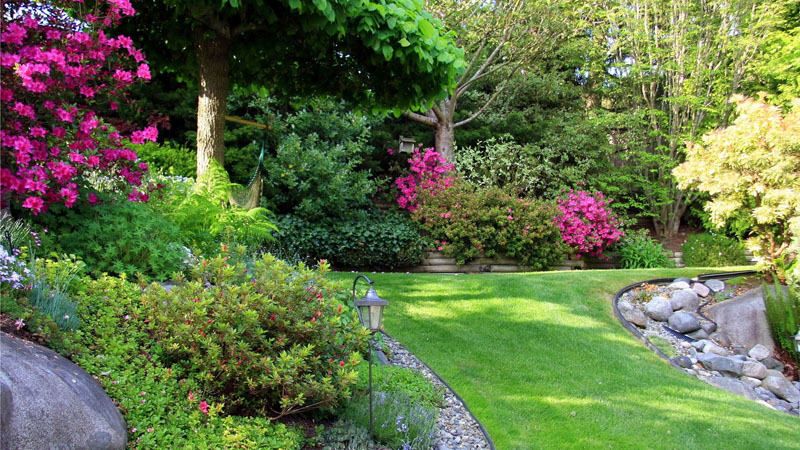
Balsam fir: description and photo
Belongs to the pine family. It is a coniferous, evergreen plant that is frost tolerant and undemanding. Under natural conditions, the tree reaches a height of 35 m, but in decorative versions it varies from 50 cm to 2 m in height.
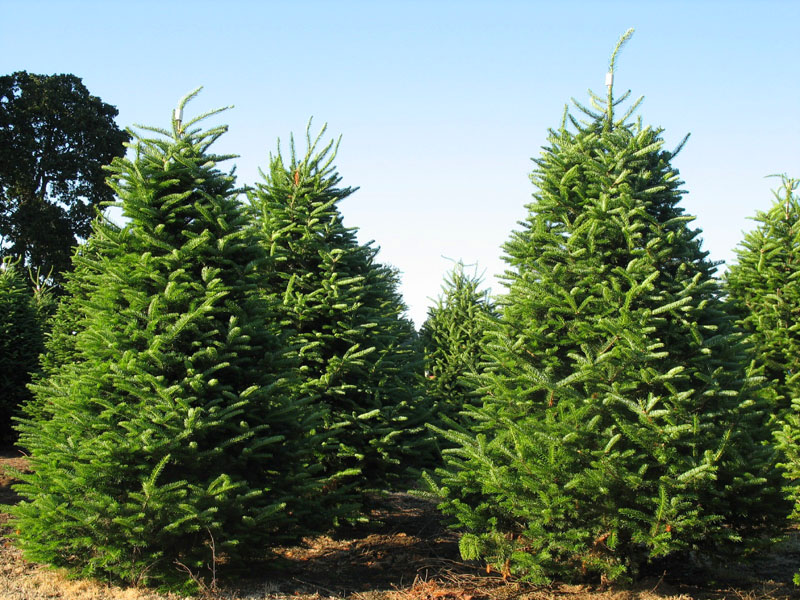
It prefers dry soil, therefore, at high humidity, a 20 cm drainage layer of medium-sized crushed stone or broken brick is poured into the trench before planting. The soil should be fertilized with a mixture of mineral fertilizers. A pit measuring 50 by 50 cm is prepared for one plant.
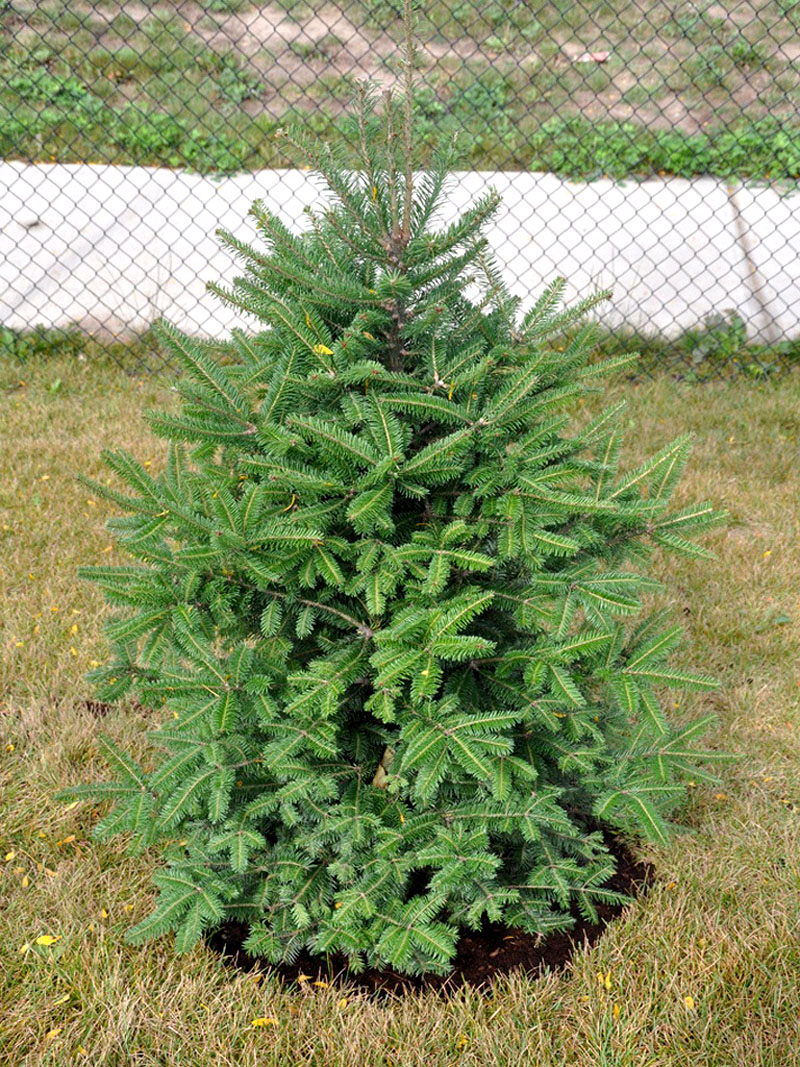
The plant tolerates frost well and develops in the shade. Requires decorative pruning with the removal of dry branches. You should not place fir in areas with strong gusts of wind: the roots are too close to the topsoil.
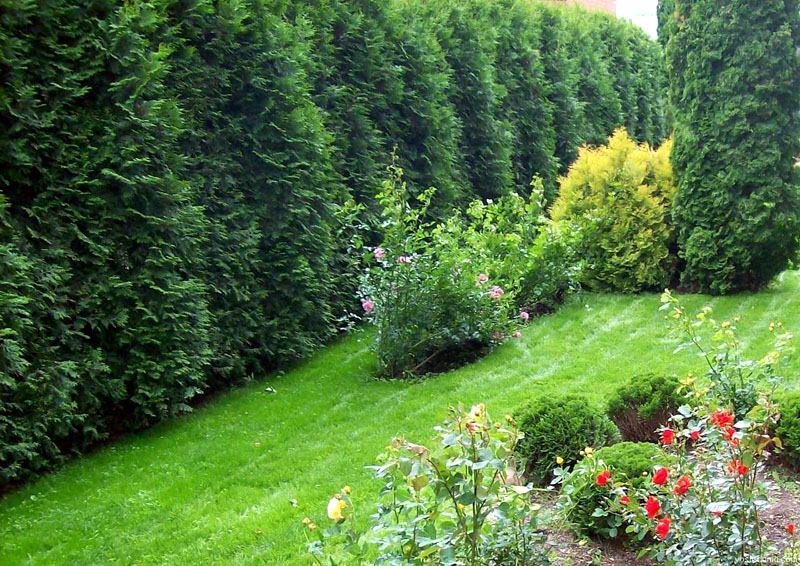
Photo of a garden ivy hedge
Perennial climbing plant of variegated color with red streaks or yellow patches. There are leaves with a white border. Looks beautiful on any fence or hedge, can braid. Inflorescences are collected in umbrellas, in total there are about 15 species.
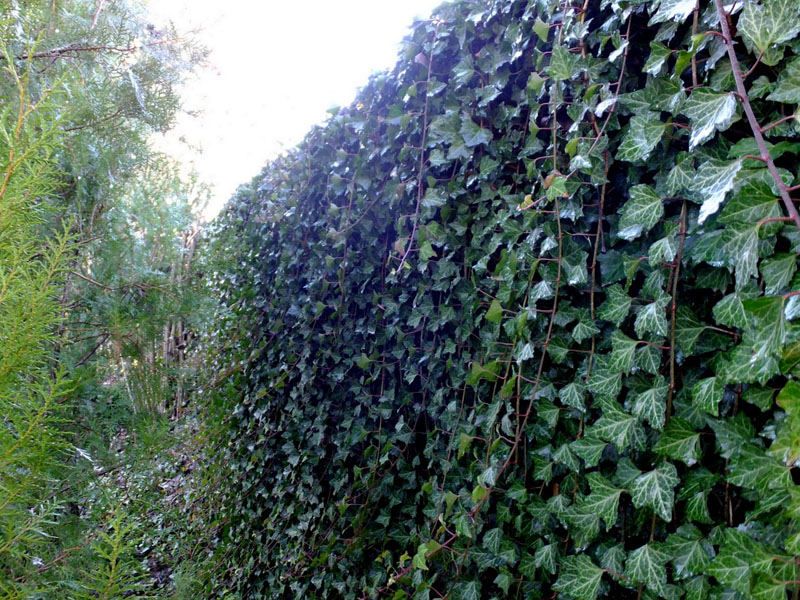
The fast-growing variety includes the Colchis variety, where the shoots reach 30 m in length. Liana grows well in soils rich in lime, so before planting in the pit, add slaked lime with wood ash, and also apply a fertilizer complex.

For abundant growth, a plant that loves moisture should be properly watered. And do not forget that working with cutting vines is worth wearing gloves.
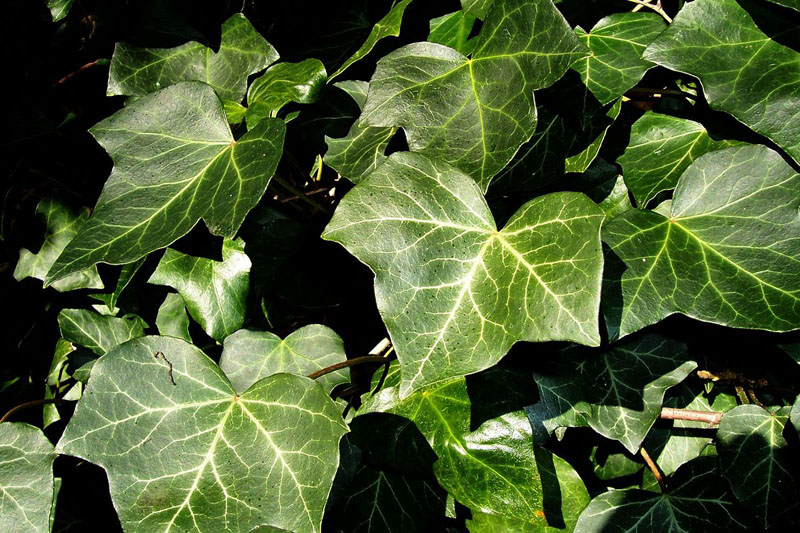
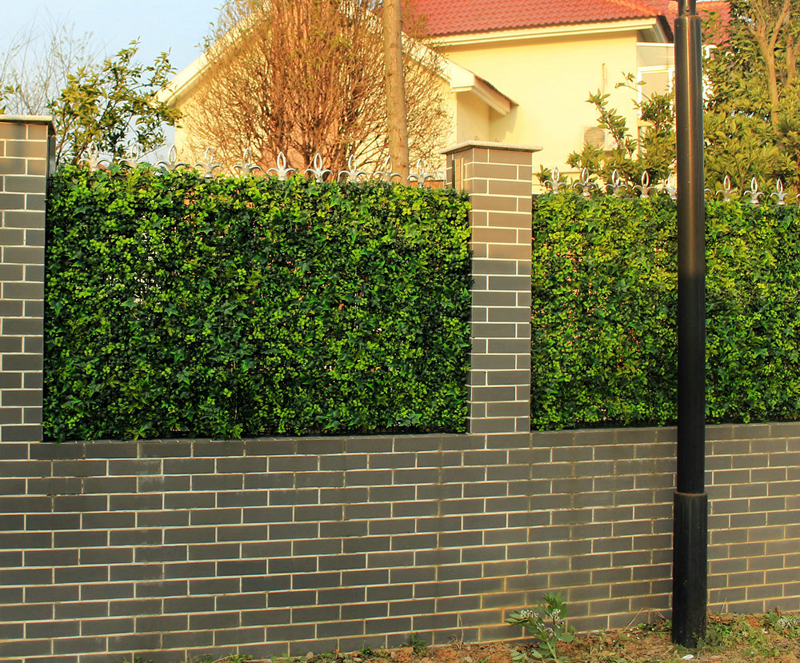

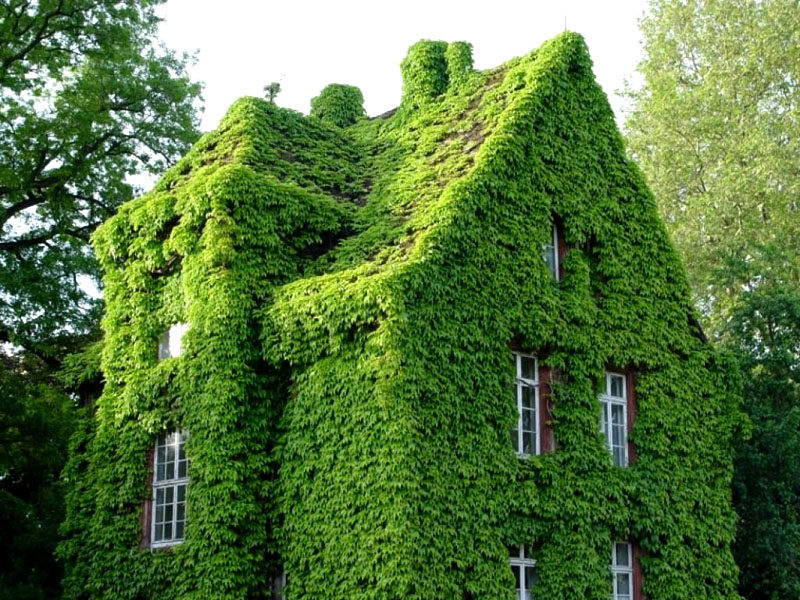
Boxwood: planting, care, reproduction
Boxwood is an evergreen plant that any gardener can plant and care for. It belongs to one of the most ancient types of ornamental shrubs, pleasing with greenery even in winter cold.
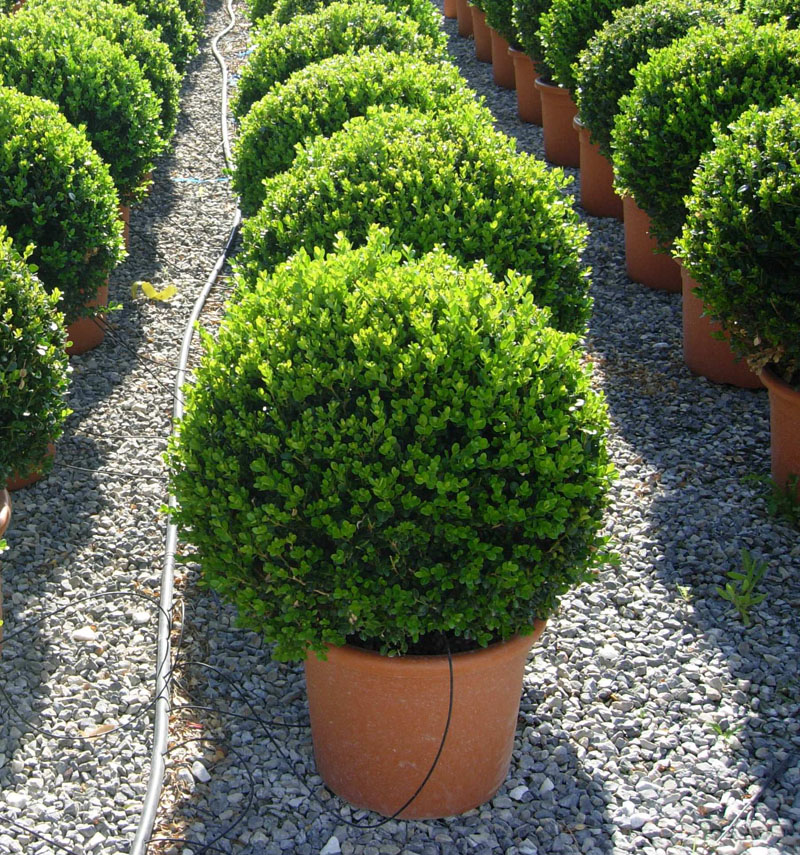
There are about 30 types of boxwood, each of which has its own uniqueness. Most often, for planting as a hedge, an evergreen or ordinary variant is used.
| Transfer | The plant is planted at the age of 3 years. There are no exact restrictions on the time of year, it is possible to plant from spring to autumn, and it is better to plant younger shoots in late autumn. It is better to plant on a cloudy day by digging a small hole, slightly larger than the size of the root system. |
| The soil | Not whimsical in the choice of soil, but a layer of compost of 10-15 cm should be laid on the bottom of the trench. |
| reproduction | Only with the help of cuttings that are planted in. About 80% of shrubs take root well in loose soil. It is better to cover new shoots with a film or a jar first. |
| Care | The plant tolerates frosts not higher than 20 ⁰, otherwise it should be wrapped or covered with burlap, and the horse system should be protected with a layer of fallen leaves. |
Important! Do not cover boxwood with polyethylene: this leads to an excess of moisture and the plant dies.
Boxwood shrub options for decor or creating a hedge:
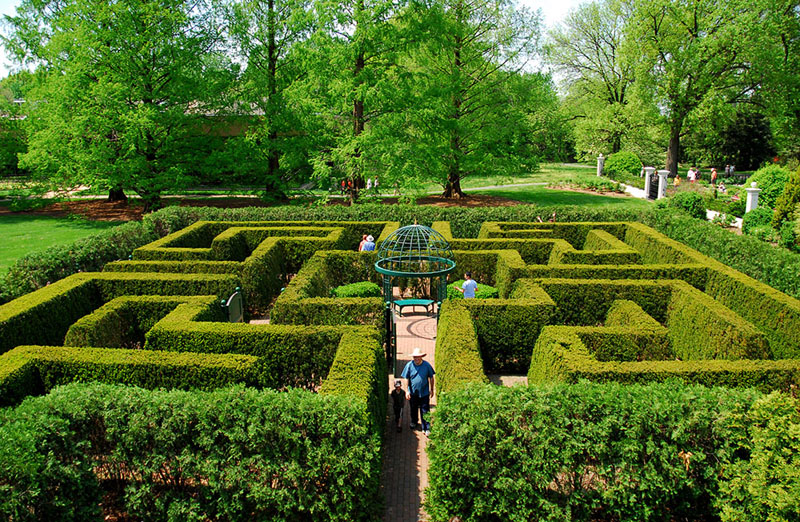
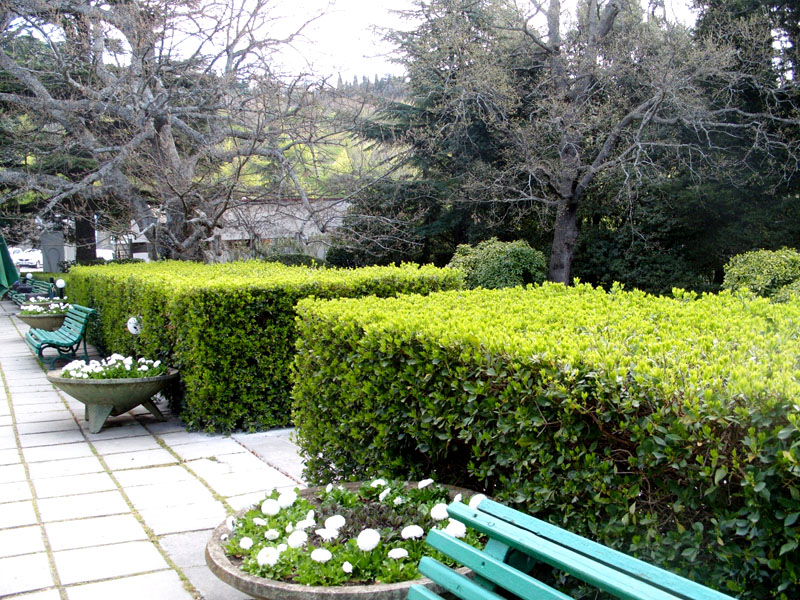

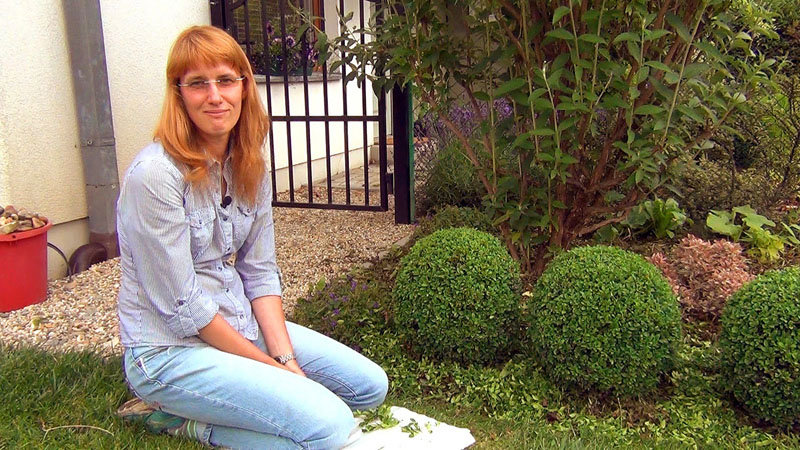
Thuja hedge
Thuja is an evergreen plant that lends itself well to shearing and does not require special care. Most often, two variants of the tree are planted: Brabant and emerald.
Thuja Brabant: description, photo
Below is a photo of thuja Brabant, planting and caring for which is not a lot of trouble. This evergreen plant withstands frosts down to -30⁰. The average height is 20 m, and in a year the tree grows by 30 - 80 cm. It is propagated by cuttings or seeds.
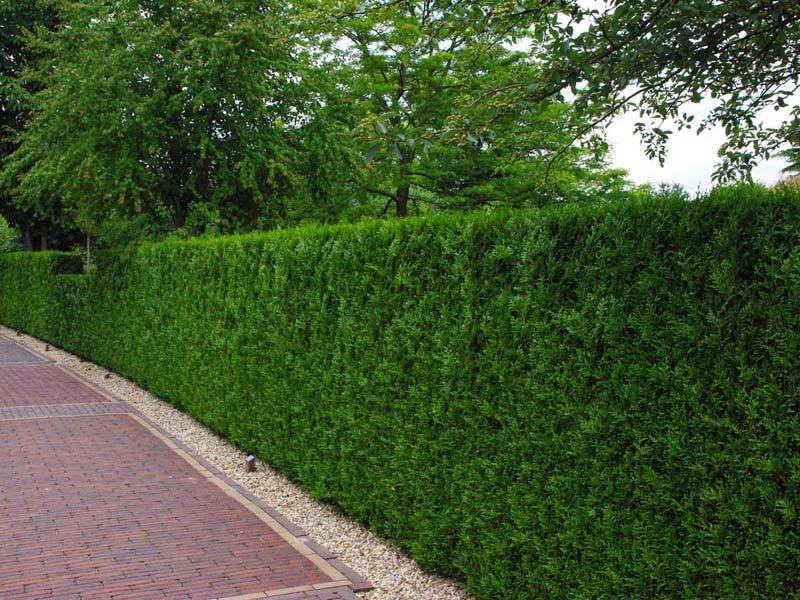
When choosing a landing site, keep in mind that thuja loves light and warmth. The brightness of the color depends on the sun's rays. But you can not allow the plant to overheat. Therefore, find a place of penumbra. It is worth planting seedlings at a distance of half a meter, since the tree has a wide crown.
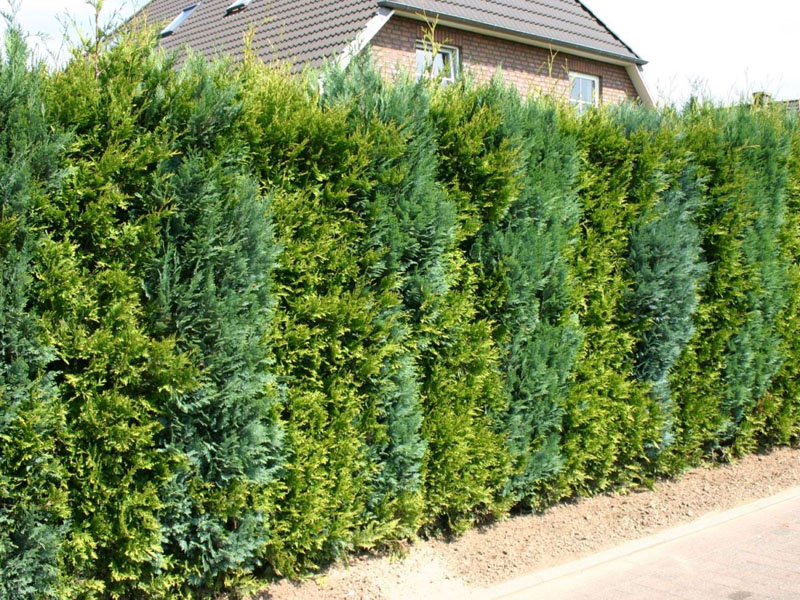
Fertilize the soil at the time of planting. In the first year, 3 more times with an interval of 4 months. Then, you can reduce to 1 time - in the spring.
Thuja smaragd: planting and care
The choice of thuja for hedges is not accidental. A unique and unpretentious plant that can be cut several times a year and planted in partial shade. The variety of coniferous thuja smaragd has a pointed shape and needles that are tightly adjacent to each other.

The color always remains emerald green, even in severe frosts. Not whimsical to the soil, but a layer of drainage should be made in the pit. He loves partial shade and does without additional fertilizers and watering.
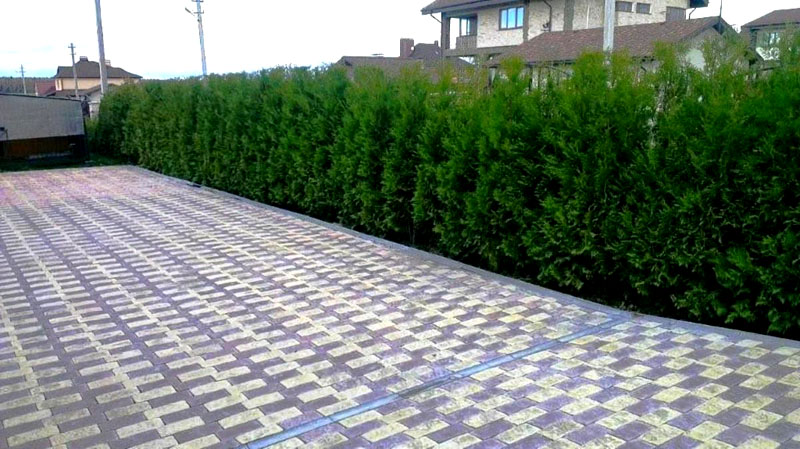
Planted by seedlings, an adult plant grows up to 5 m in height. Perfect for creating a green "fence".
Article
The fence is necessary to hide our little country world from prying eyes. However, today summer residents want not just to get a fence, but to surround their charming garden with an equally beautiful hedge. Or maybe someone just wants to arrange tracks or. And in this case, a hedge will come to the rescue. What is the best way to make it so that the care is minimal and the efficiency is the highest?
Hedge - what is better to make
Types of hedges
A hedge is a kind of "flower bed", planting, which serves to designate a specific area or to protect it. Often performs an aesthetic function. A hedge is traditionally created from shrubs or trees, but natural hedges of grasses and even vines can be found, but these usually still serve to complement and decorate more durable options for a plant “fence”.


The history of hedges dates back centuries, so it is not surprising that they have a large number of variety of shapes and sizes. First of all, they are classified by height.

Table. Classification of barriers depending on the height.
| Type name | Height, m | Description |
|---|---|---|
| Border | Up to 1 | This is the lowest version of the living barrier, a kind of discount. Commonly used for framing garden beds, paths, paths. For cultivation, such crops as heather, Japanese quince, alpine currant, wild rose, sea buckthorn are used. The most important thing is that the plants are slow growing, small and have small leaves. |
| Average Height | 1-3 | Shrubs and - sometimes - low trees are used to create such hedges. For example, mock orange, barberry, western thuja, acacia, euonymus, juniper, lilac and others are great. Usually such hedges advantageously divide the garden into sections - that is why they are used. |
| living wall | More than 3 | Such living "fences" are the real defenders garden plot from wind, noise, dust and exhaust gases with highways. Willow, spruce, thuja, hornbeam, apple tree are used for growing such walls. The main thing is that the trees are of those species that can easily tolerate a haircut. Such hedges are planted around the perimeter of the site. |

Note! Almost each of these options will be quite harmoniously combined with stone, iron. That is why often living fences are not continuous - some of their sections are an ordinary, not natural fence.
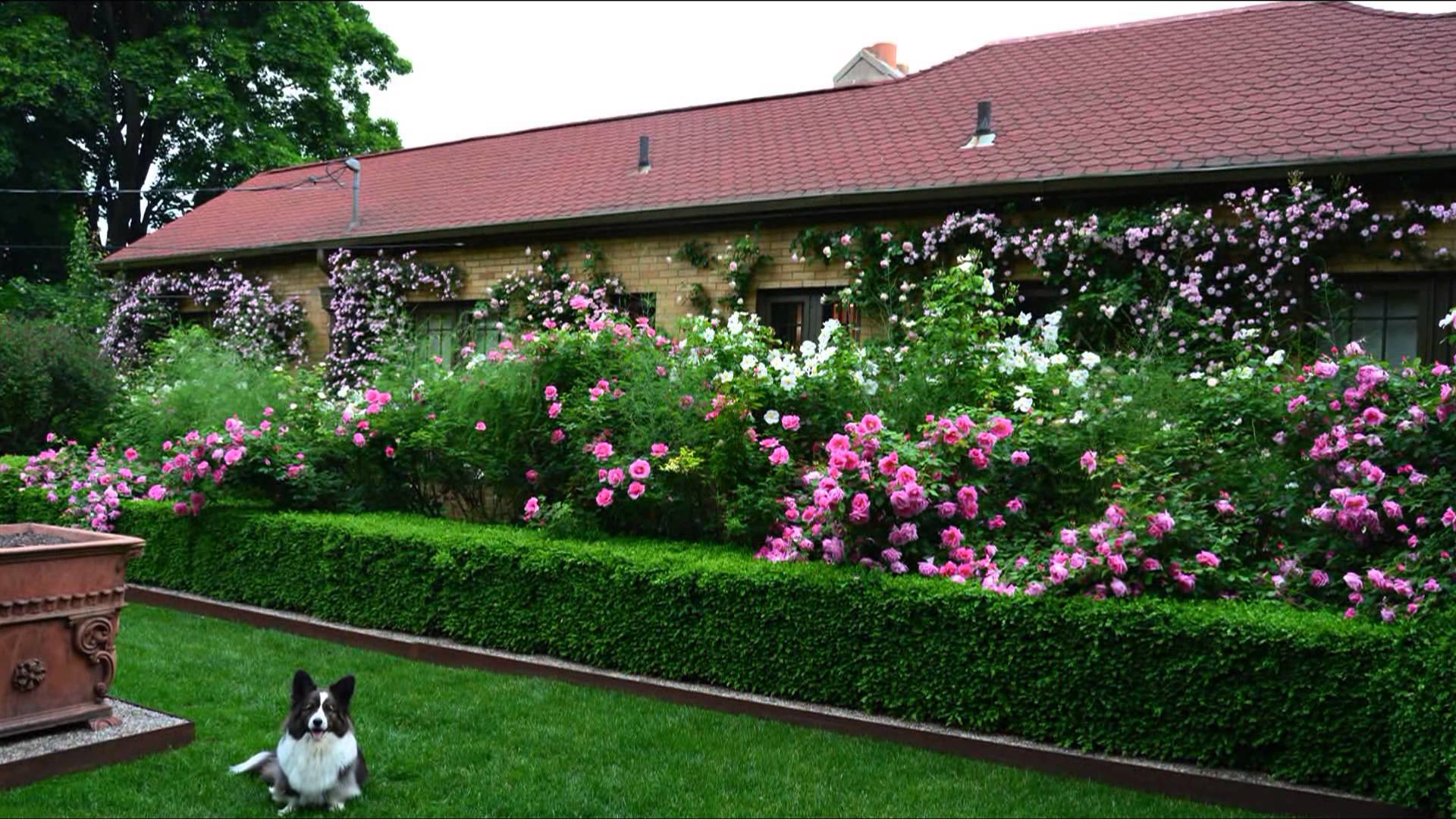
Another "dimensional" version of the classification of hedges is their row or width.
- Single row- in this case, all the plants that form the hedge are planted in one row and at an equal distance.
- double row- respectively, they have two rows of plants planted in several lines, most often in tiers.
- multi-row- three or more rows of plants. Usually in this case, crops are planted in a checkerboard pattern, taking into account the distance from the trunks and crowns in the future. Tiered hedges are often made cascading.

Other types of hedges
According to the care technique, two types of hedges are distinguished - these are free-growing and sheared (or shaped). The former usually form their crowns without human help, growing in the way that suits them. The latter, on the contrary, can take the form of various figures at the request of the gardener. Require regular pruning shoots. And the plants that make up such hedges should calmly endure the shearing process and have a thick, dense crown.

Note! Most often, hedges are cut in the form of a triangle (the slope of the sides is 70-80 degrees) or a trapezoid (bevel more than 10 degrees). You can often see rounded hedges - this is the most difficult haircut option.

Also, depending on the types of crops, these types of hedges are distinguished:
- blooming;
- curly;
- evergreen;
- deciduous.

There is another classification of hedges:
- single-species - formed from trees of the same species;
- combined - include various types and varieties of plants;
- trellis - are formed from plants whose branches are intertwined.


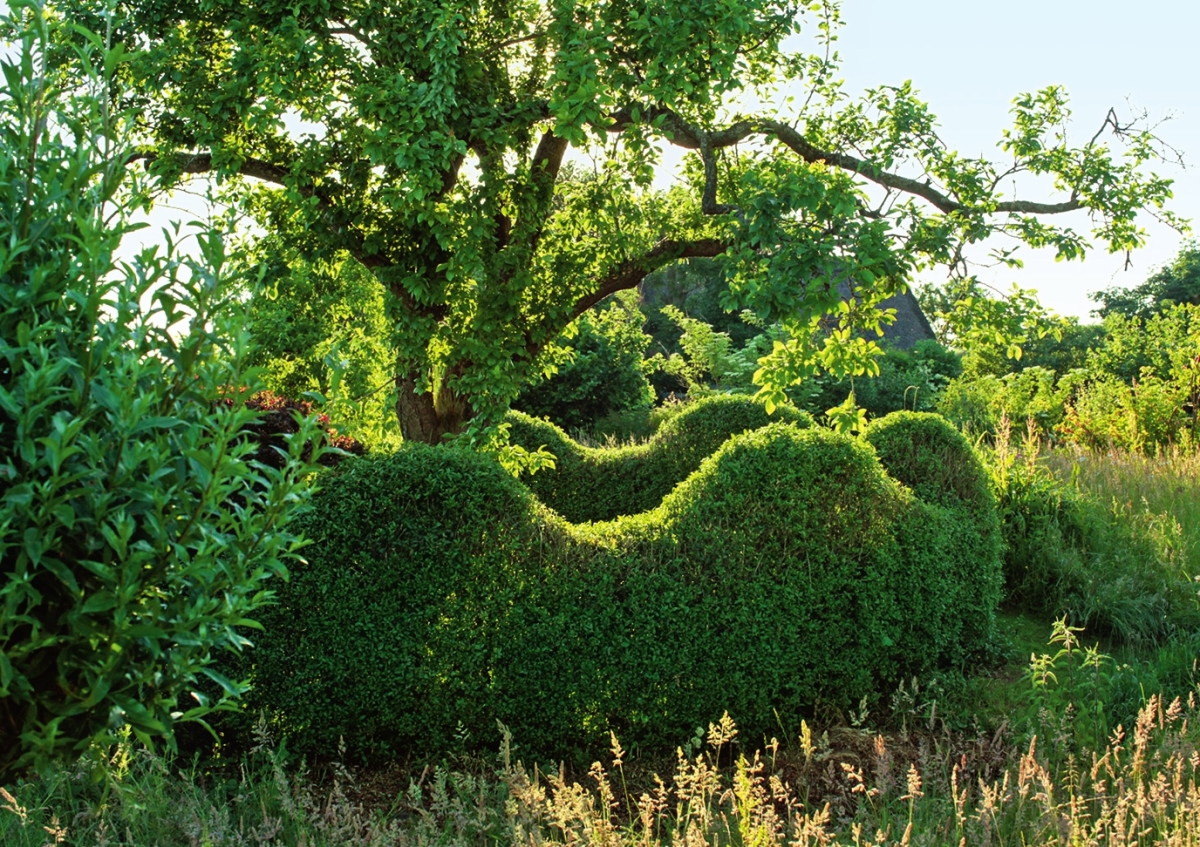
Give the wall a wave shape - so the hedge will look more dynamic
Advantages and disadvantages
Any hedge, whether multi-row or planted in one line, single-breed or combined, has advantages and disadvantages. Both those and others need to be known in order to understand whether such a fence is needed in your summer cottage.

Advantages of plant hedges:
- natural aesthetics;
- protection of plantings and soil on the site from erosion, exposure to strong winds;
- better moisture retention in the soil;
- shelter from the summer heat.

Disadvantages of hedges:
- complex care - haircut, fertilizer, watering and much more;
- covering large areas of land;
- long term implementation of the idea to acquire a hedge.
hedge plants
There are many plants from which you can form a hedge. However, there are several principles that are important to follow when choosing them: for example, you should choose those crops that are suitable for growing in specific climatic conditions. It is also better to use plants that are not afraid of the cold, tolerate a haircut well and do not get sick after it. The foliage should be dense, and the shoots should be fast-growing. Consider the main crops that are used to grow hedges.

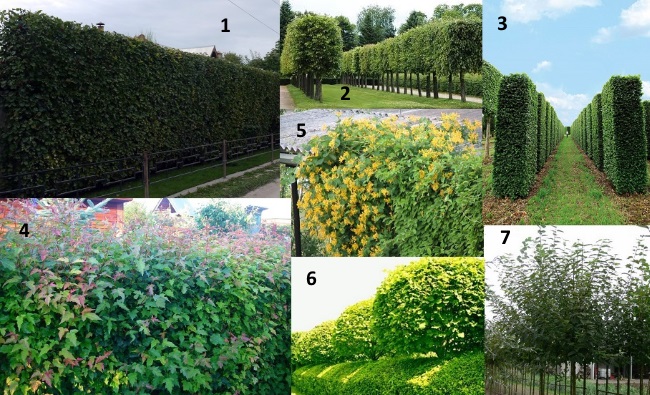
A hedge of popular tall plants: 1) Siberian hawthorn, 2) small-leaved elm, 3) common hornbeam, 4) Tatar maple, 5) golden honeysuckle, 6) small-leaved linden (lower tier - cotoneaster), 7) Berlin poplar
Lilac
This charming shrub is familiar to everyone thanks to fragrant lilac flowers. Lilac feels great in the temperate climate zone, frost-resistant, photophilous, loves fertile soil, copes well with drought, long-liver. The plant has a lot of varieties and species, and therefore among this variety it is easy to choose the one that you like (Amur lilac, Hungarian lilac and others).

Active flowering is observed in summer and lasts about 2 weeks. During this period, lilac is especially beautiful. In general, this is a fairly large and lush plant.
This maple has been used in horticulture for about two centuries. It is a small tree with a dense crown, which is excellent for growing as a hedge element. It is especially beautiful in autumn, when the leaves are painted in bright crimson colors. At the same time, the tree is easily cut and grows quite quickly.
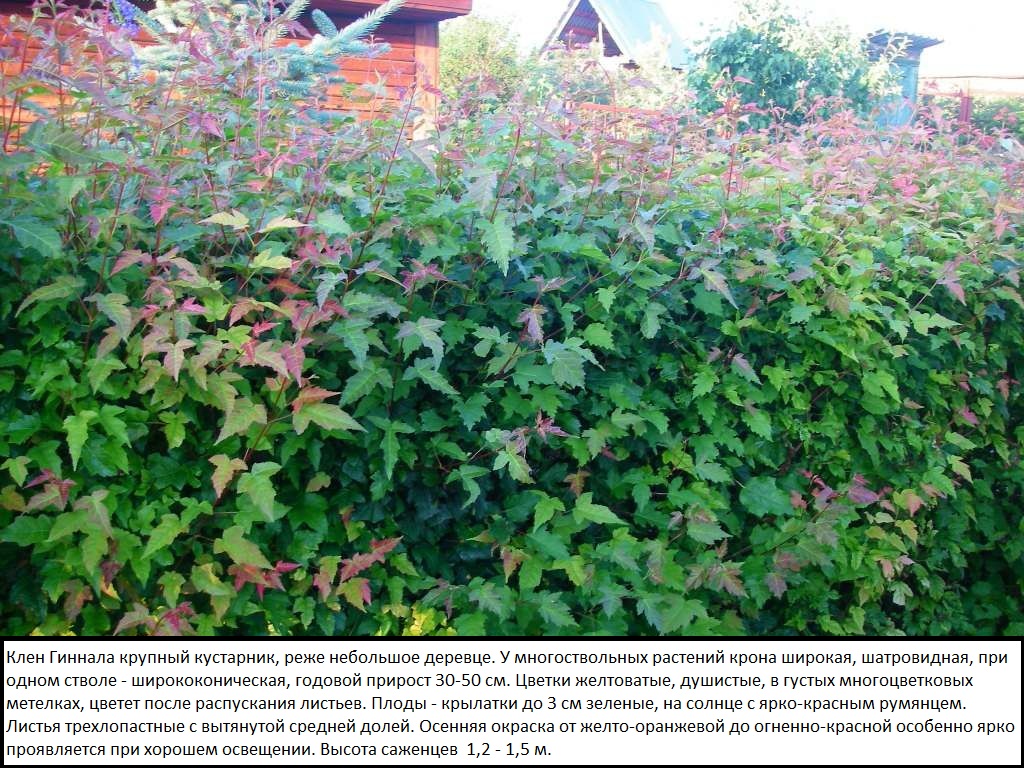
The minus of the Ginnal maple, and indeed of any maple, is the tendency to create abundant root shoots, and in the shade the leaves of the plant lose their bright color.

rock juniper
Juniper belongs to the Cypress family. A beautiful plant with a narrow pyramidal crown. Used as a cultural from the last century. Juniper loves a lot of light, in shaded areas it loses its charm and beauty. The main drawback is that it does not like cold weather and does not resist frost well. It also needs regular watering in the summer, and for the winter the crown should be tied with a rope so that the branches do not break due to heaps of snow that have settled on them.

Irga
This shrub is not only beautiful and neat, it is also useful - the berries growing on the branches of the shadberry are very tasty and suitable for making jams and preserves. The life expectancy of a plant is high - up to 70 years on average, while an adult culture is quite appearance may resemble a tree. In general, this plant is unpretentious, calmly tolerates some shade and gas pollution of the city, as well as drought and wind. The winter hardiness of the irgi is very high.

On a note! Irgi berries secrete juice that can stain everything around and is poorly washed. That is why irgu is not used as a hedge near parking lots.
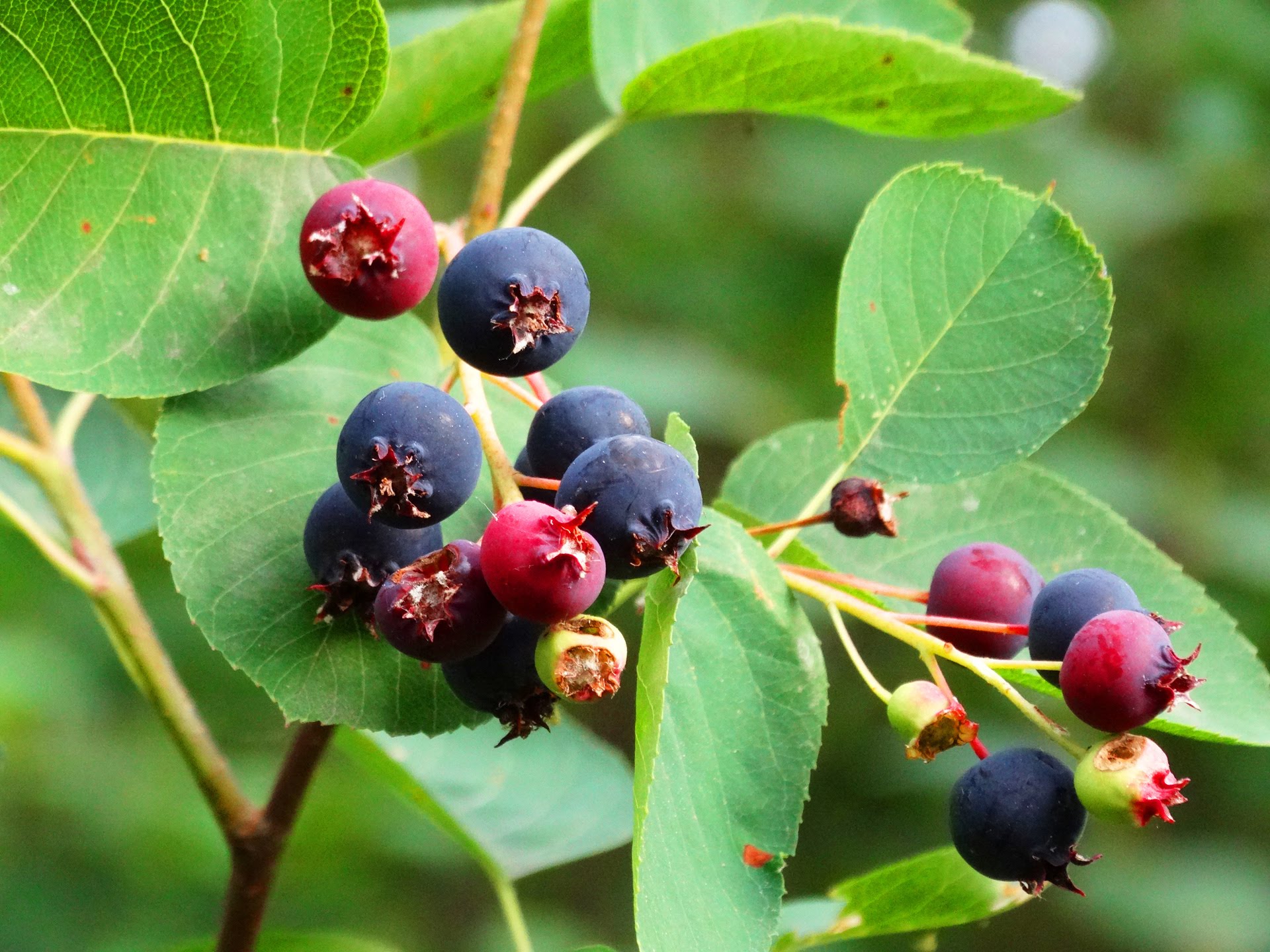
western thuja
This evergreen coniferous plant is also called the tree of life. Widespread in North America. Thuja is winter-hardy, perfectly tolerates city conditions, is unpretentious, and therefore is now widely used in horticulture. This is a tree that grows very slowly, it has a pyramidal or egg-shaped crown.

Brilliant Cotoneaster
This shrub is used to form low hedges, as it is quite low itself (maximum 3 m). If he likes the growing conditions, then the cotoneaster grows very quickly. The plant has small leaves covering the branches with a solid green carpet. The cotoneaster is not afraid of shade, is not capricious about the soil, is not afraid of frost, but needs timely and regular pruning.

Table. Hedge crops that are grown in the middle lane.
Growing a living fence
How to create a hedge on your site depends directly on the type of fence and the crops used to create it. But there are general points of instruction that are suitable for all options.
Step 1. We choose a place where the hedge will pass. Usually this is the perimeter of the site or a place along the garden path or flower bed. The place should be well lit.

Step 2 Taking into account all the rules, we choose the plants from which we will form a hedge. We buy seedlings.

Step 3 In the area where the hedge will be planted, we remove all weeds, dig up the soil.

Step 4 Be sure to fertilize the site by adding a little fertilizer to the soil.

Step 5 We plant plants taking into account their requirements for transplantation, soil.
Attention! Do not forget to maintain a certain step between crops when planting. The planting step for shrub plants is at least 50 cm, for trees - 75-100 cm.
Step 6 Sprinkle a little soil along the line with mulch, water the plantings.

Step 7 Plants that form a hedge need careful care - watering, fertilizing, etc.

Step 8 We cut the plants about once a year with special pruning shears.
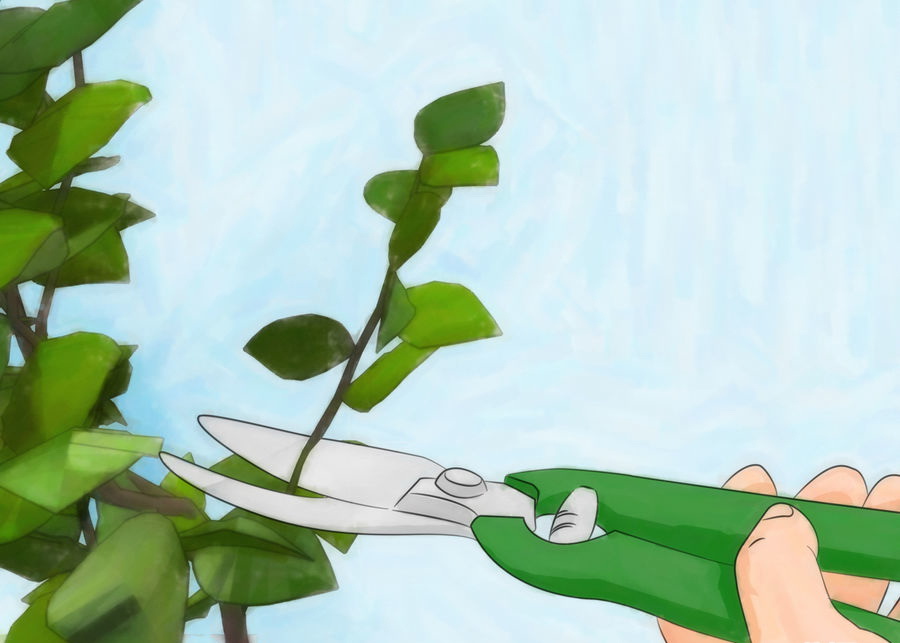
It is worth remembering that a hedge will not appear overnight. The approximate period of its development and formation is 3-5 years.
Flower beds from annuals - schemes
Flowers are grown, as a rule, not randomly, but in flower beds, in beautifully designed flower beds. At the same time, they are selected according to color, crop varieties and many other factors. And to make flower beds from annuals, the schemes of which you will find in, on your own, you do not need to have the skills of a landscape designer.
Planting a hedge depending on the type of plants
The technology of planting hedges in some way depends on which plants will be planted. For example, a deciduous hedge is often formed from purchased seedlings of trees and shrubs. Their root system is usually bare, and therefore it is important to inspect it well before planting and, if necessary, remove rotten or diseased roots. The hole is made in such a size that the plant can easily fit into it. In this case, the soil from the pit is mixed with compost and then returned to the hole.

On a note! If very tall plants are planted, then a wooden stake is driven into the bottom of the hole to support them and tie them up.
Planting conifers is a little easier. Having dug a hole with a diameter twice as large as the roots, the plant is lowered into it and buried with compost.
The trellis fence is one of the most difficult to form. In this case, all plants are planted close to each other. After a couple of years, not hygienic, but total pruning of trees is performed, after which the strongest shoots remain - they begin to intertwine with each other at an angle of 45 degrees. In those places where the bark is in contact, it is cut off with a knife. It turns out a diamond-shaped pattern, which, if necessary, can be tied up according to a hammered pattern.

Haircut rules
And finally - a few rules for pruning shrubs. Deciduous crops are pruned immediately at the beginning of the procedure. At the same time, about 15 cm of the plant remains above the soil surface. And after a year, plantings should be cut about 3-4 times during the season.
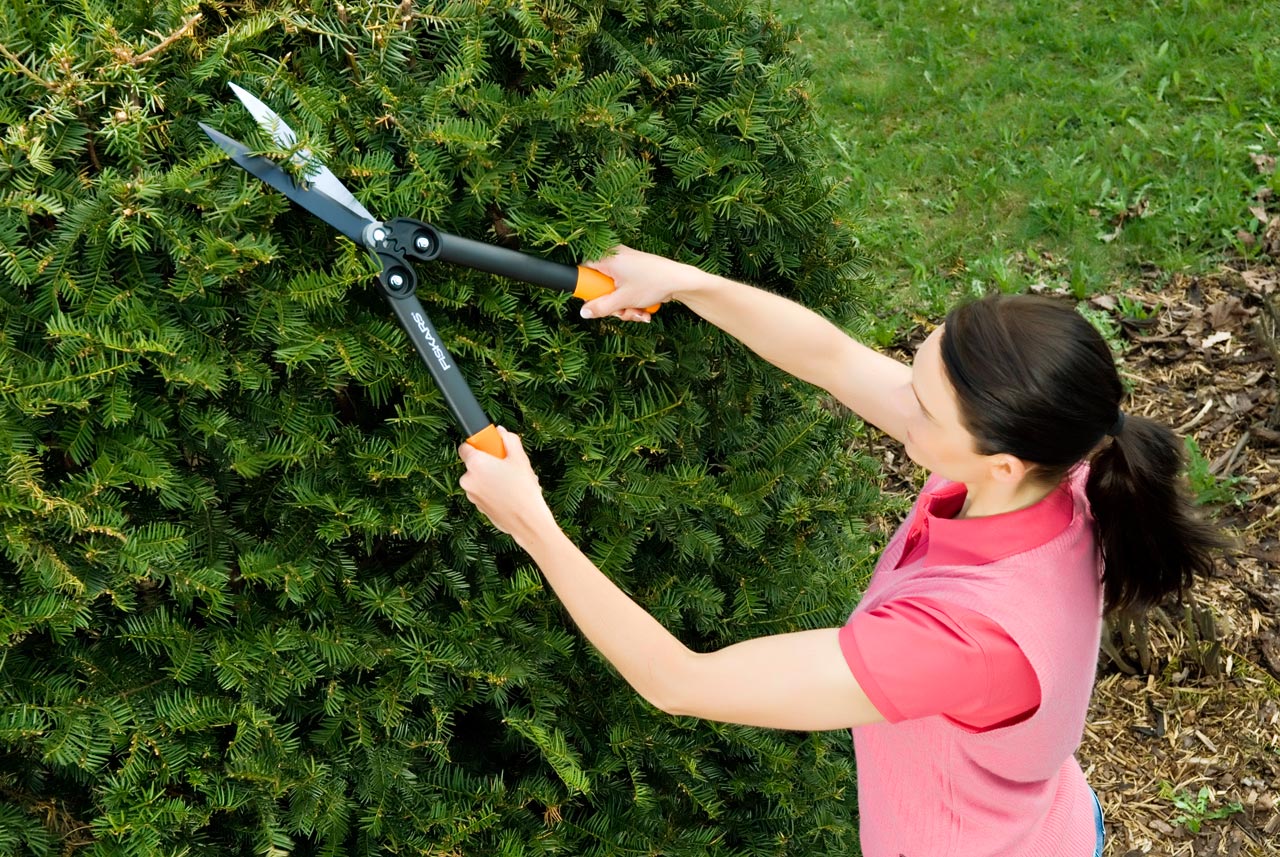

But juniper, cypress, conifers and others are not completely sheared - usually individual branches are removed from them so that the crown is triangular.


Makita UH6570 - brush cutter
Video - Create a hedge
This is how you can get a hedge on your site. It is worth being prepared for the fact that it will require a lot of time and effort. It does not hurt to master the technique of cutting, so that later you can perform this procedure yourself.

A solid hedge is beautiful!



